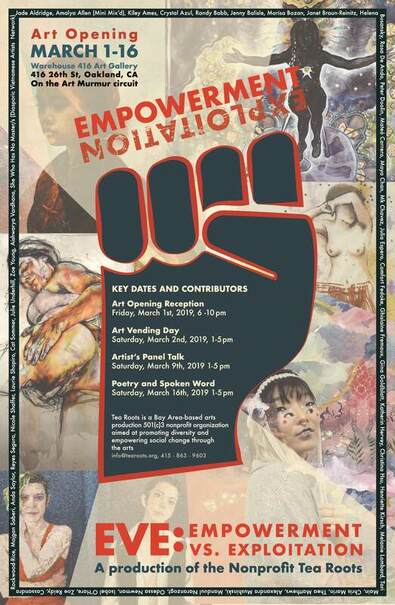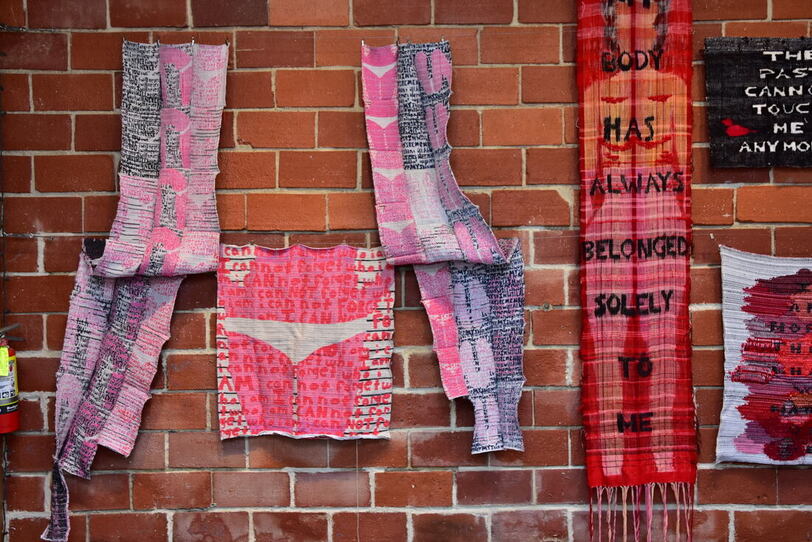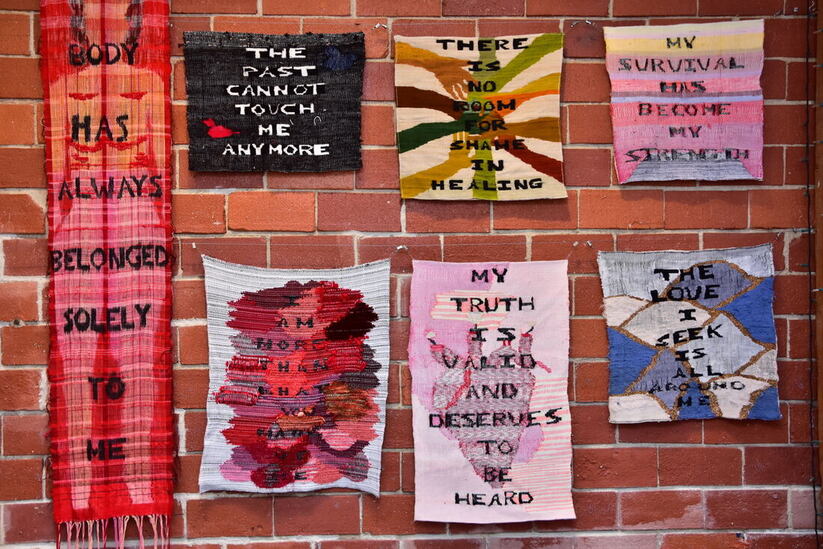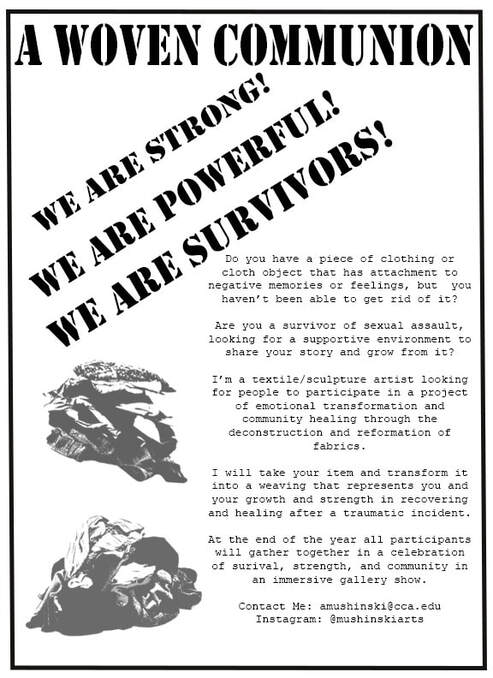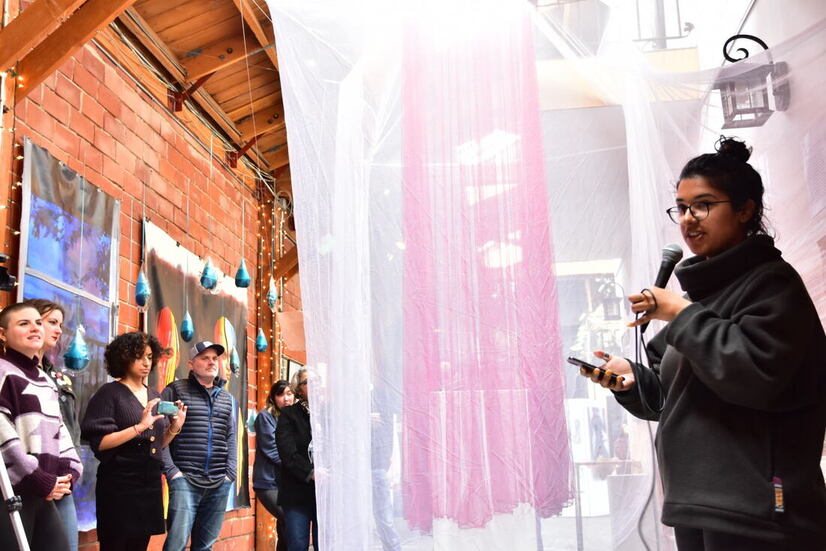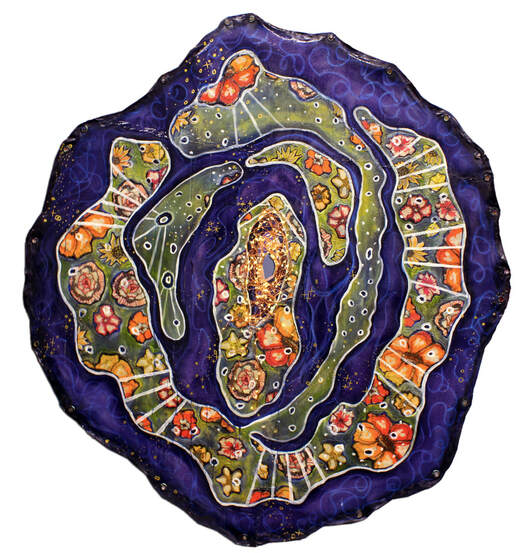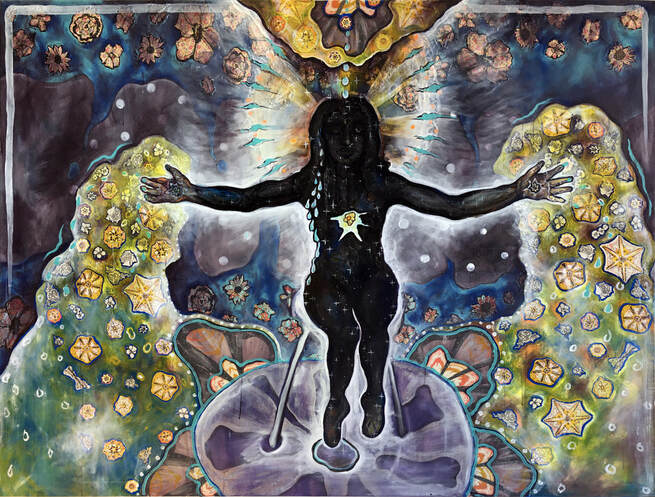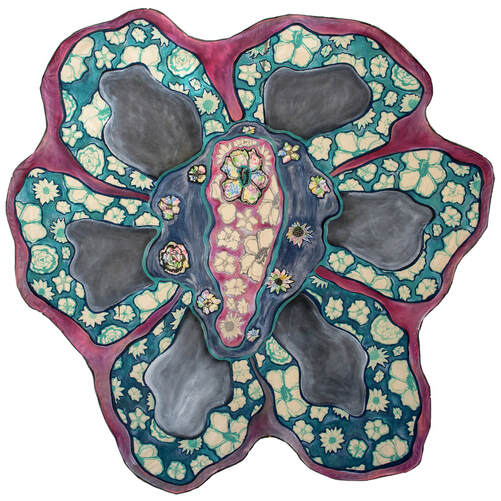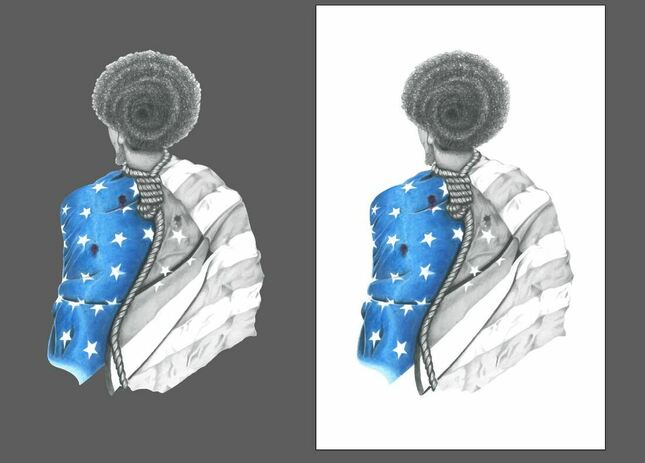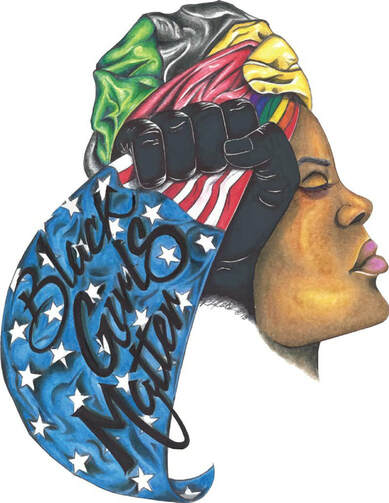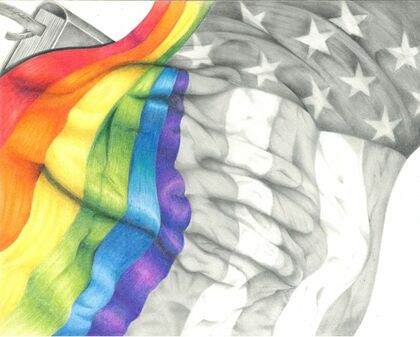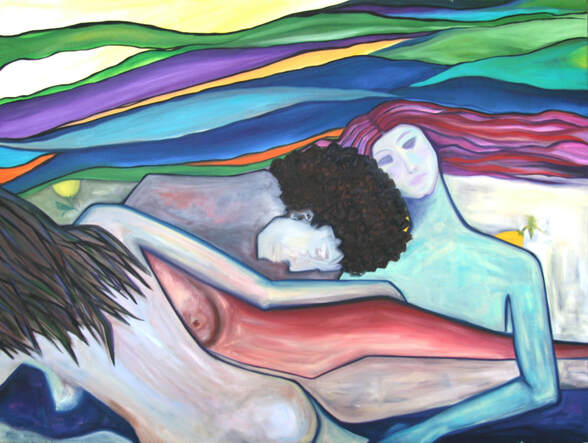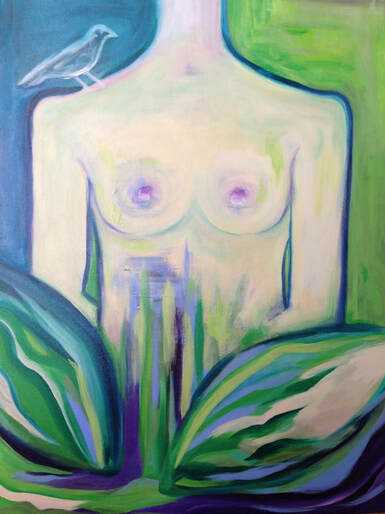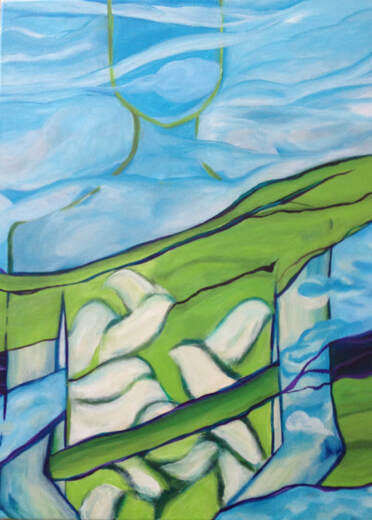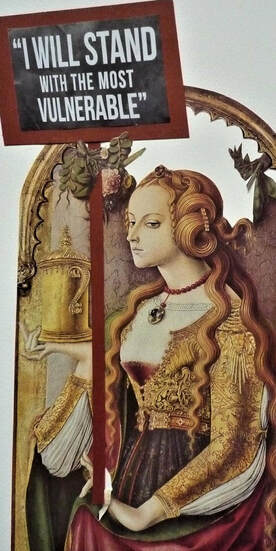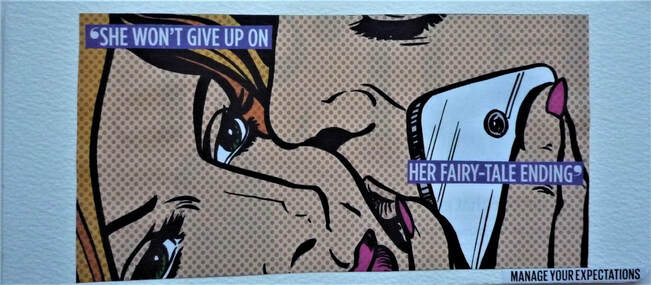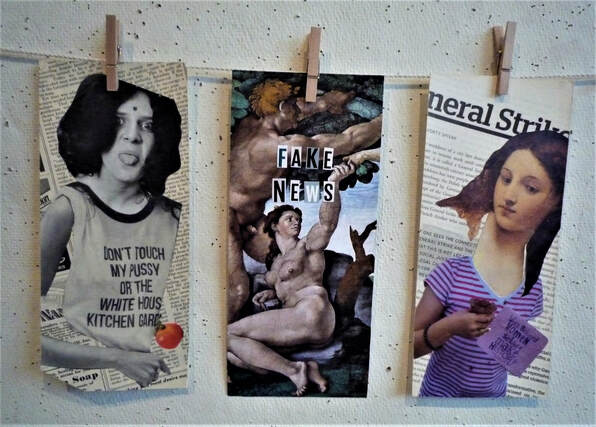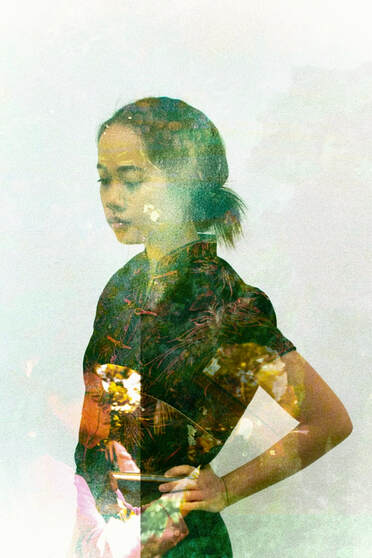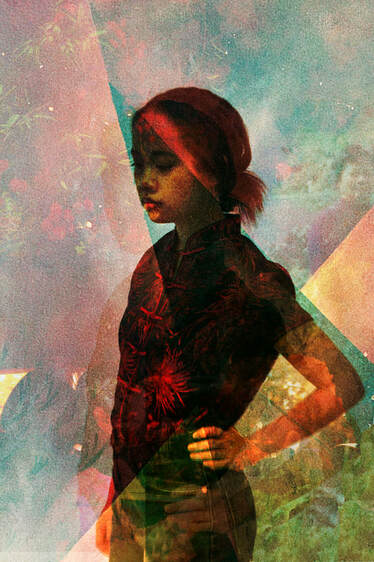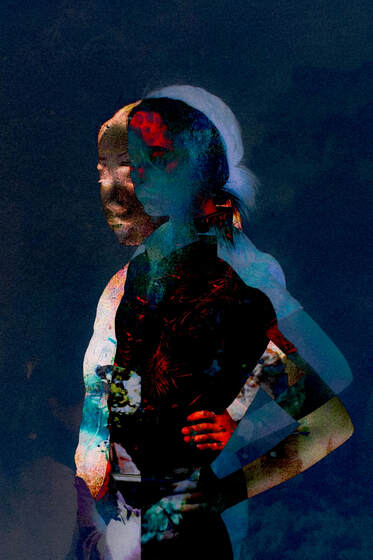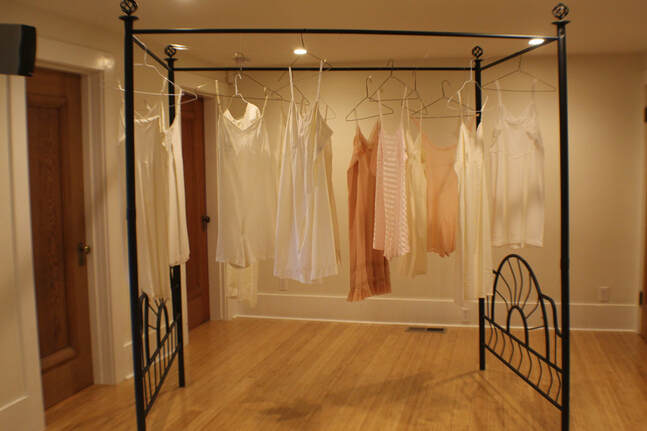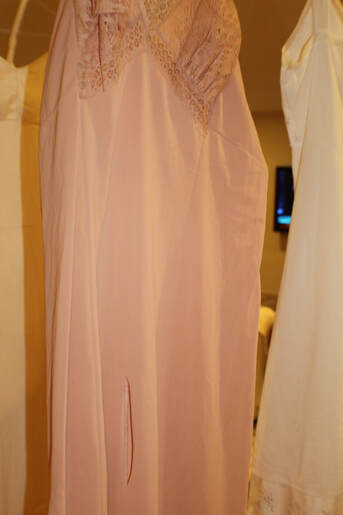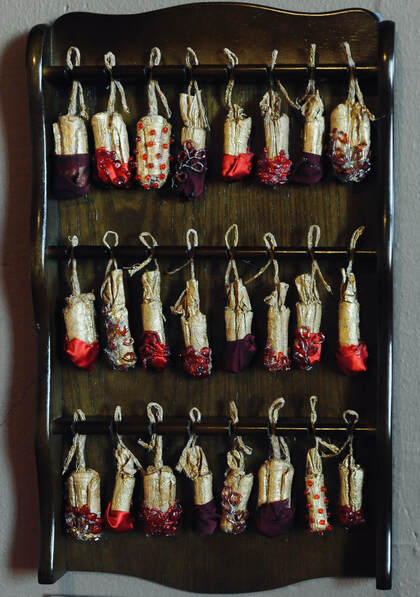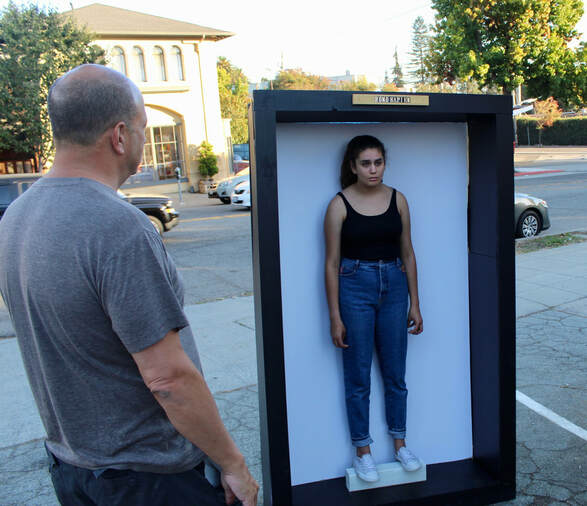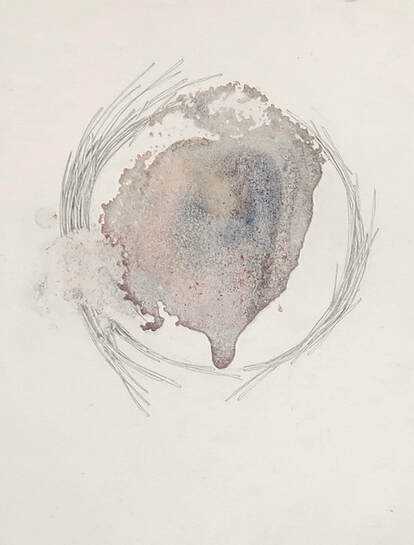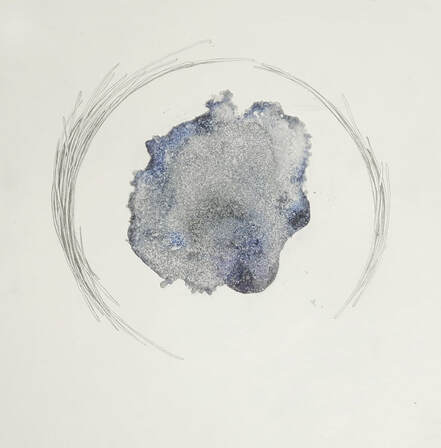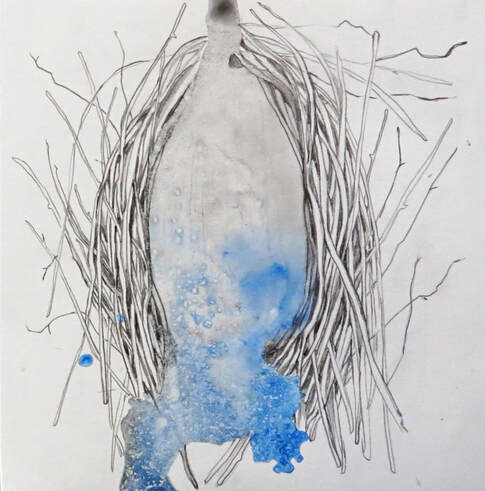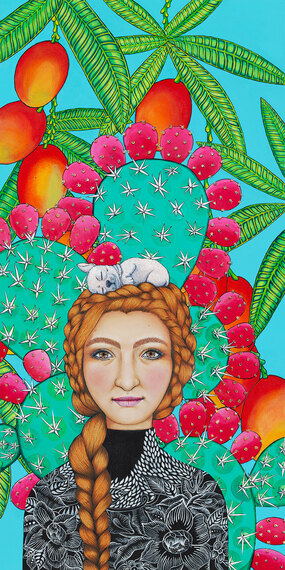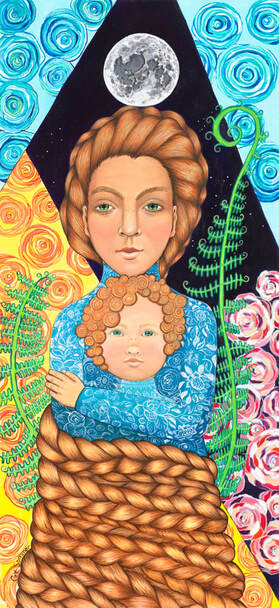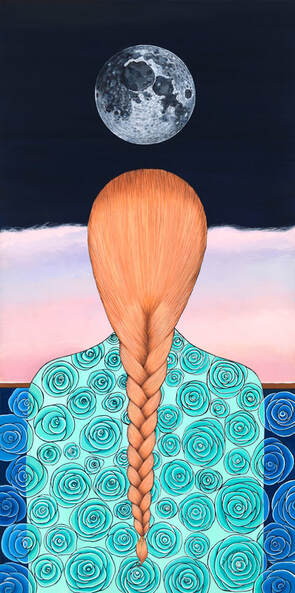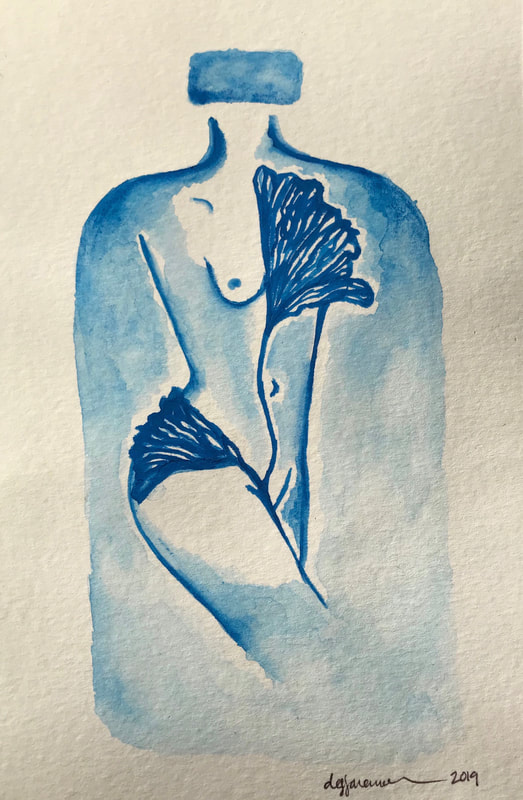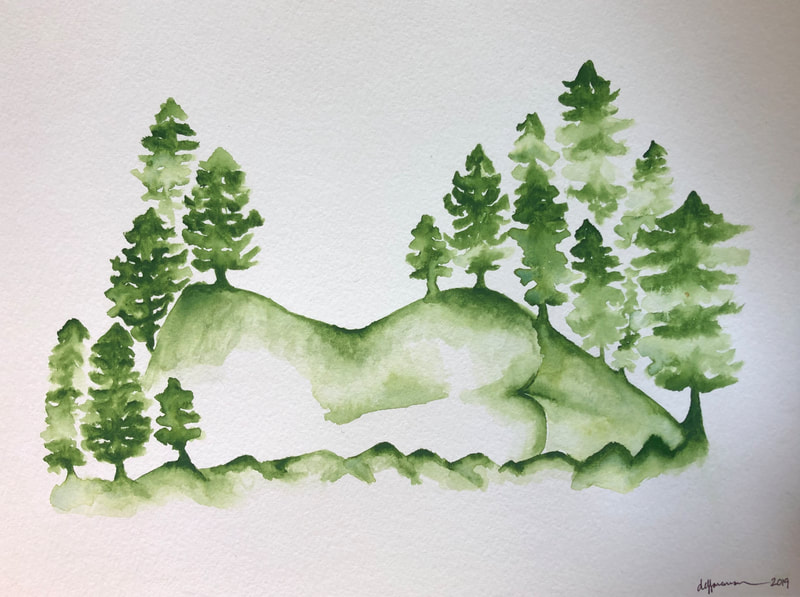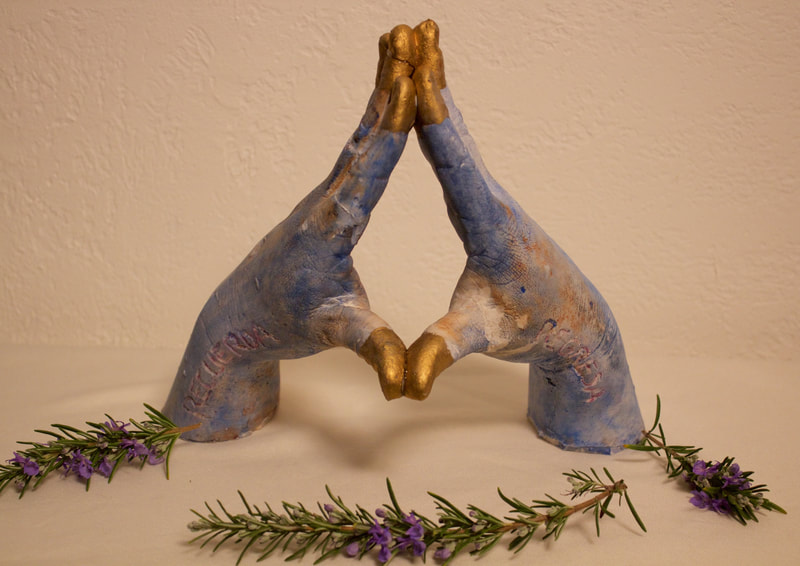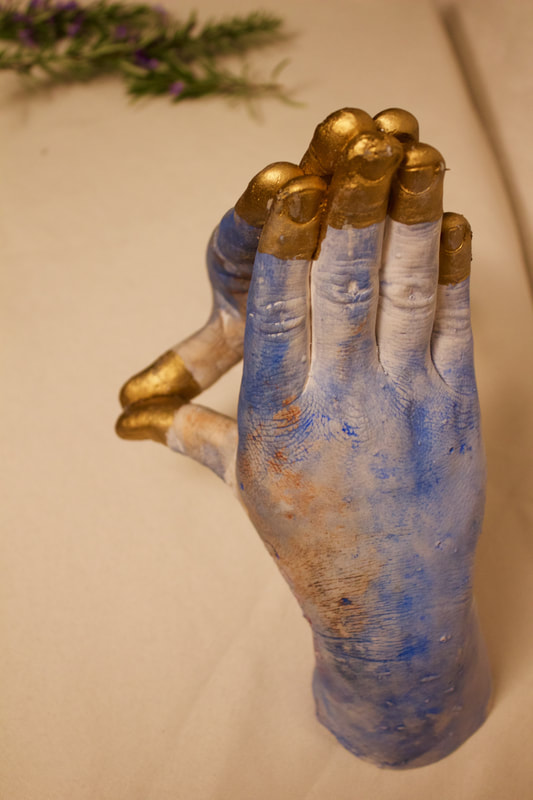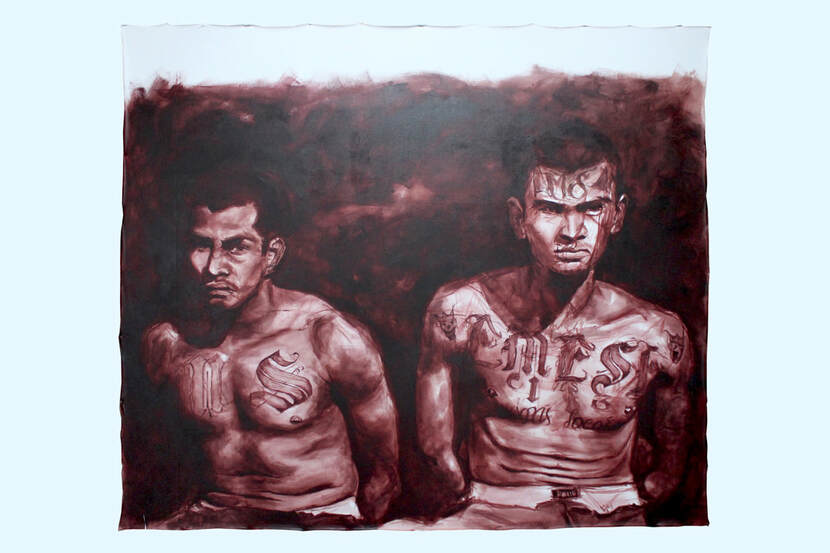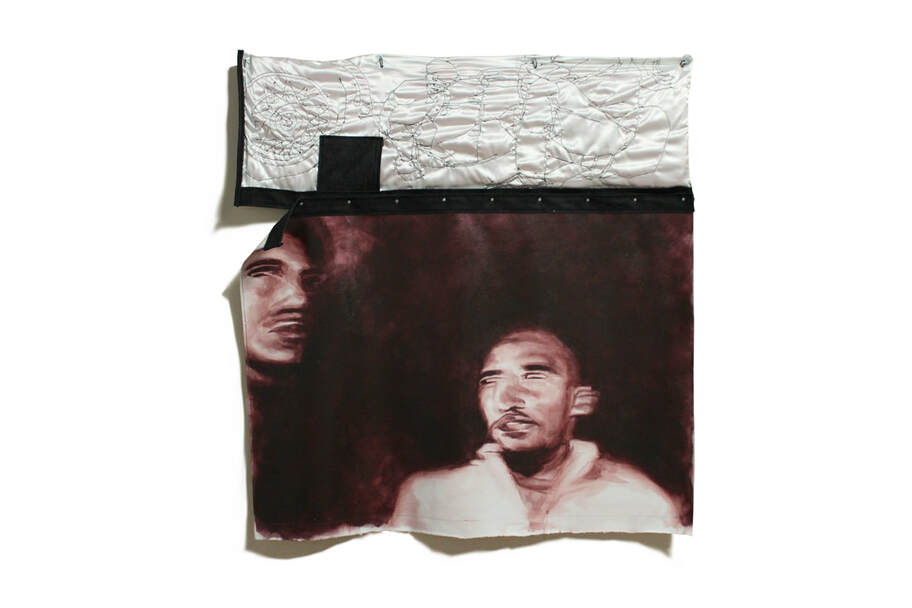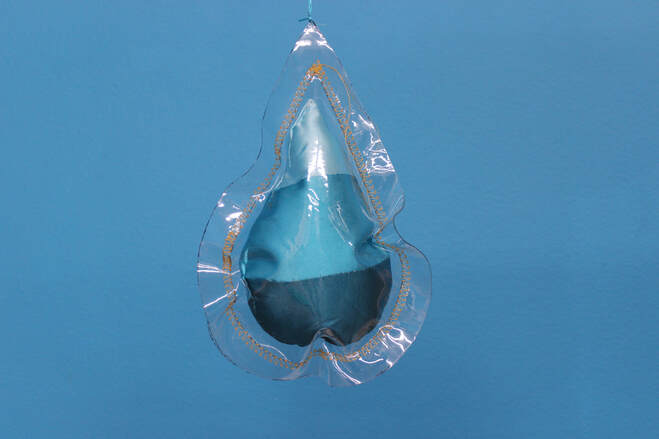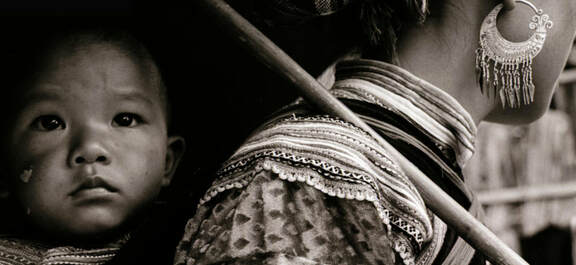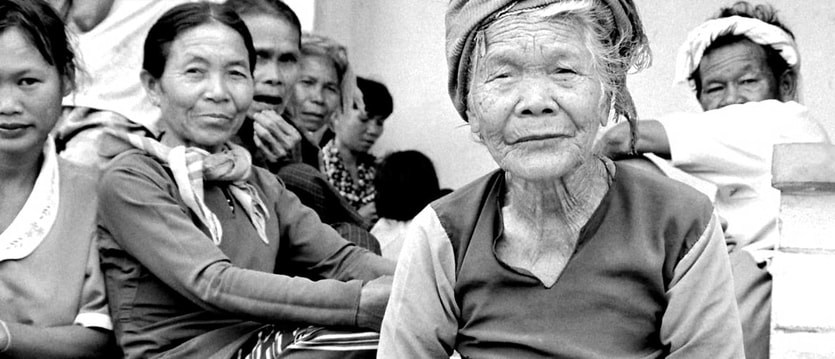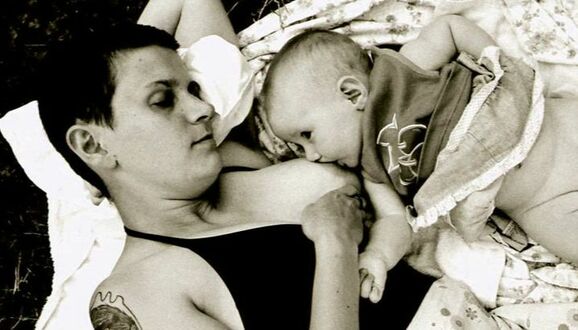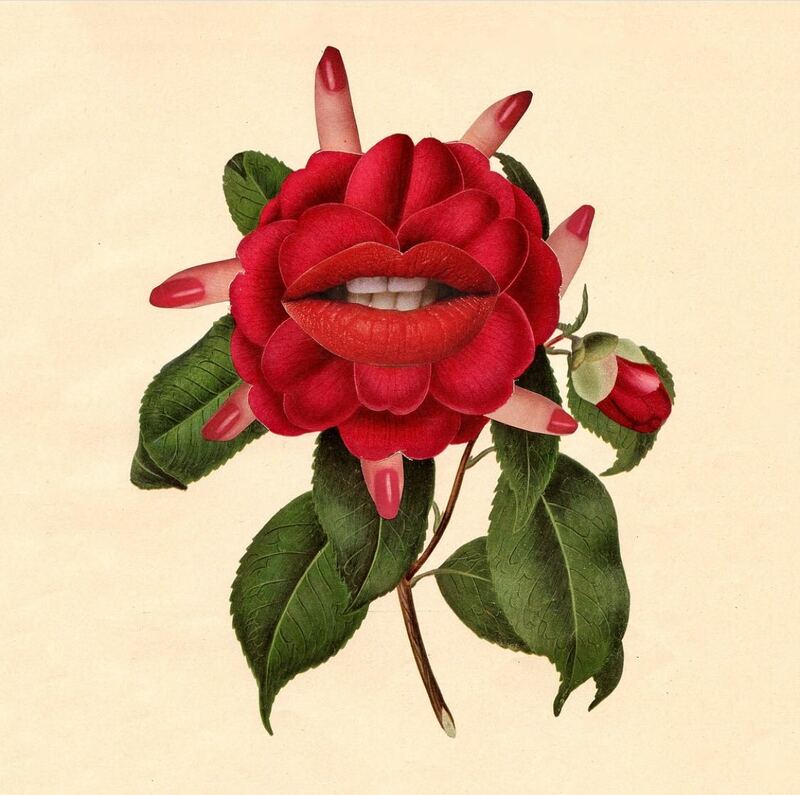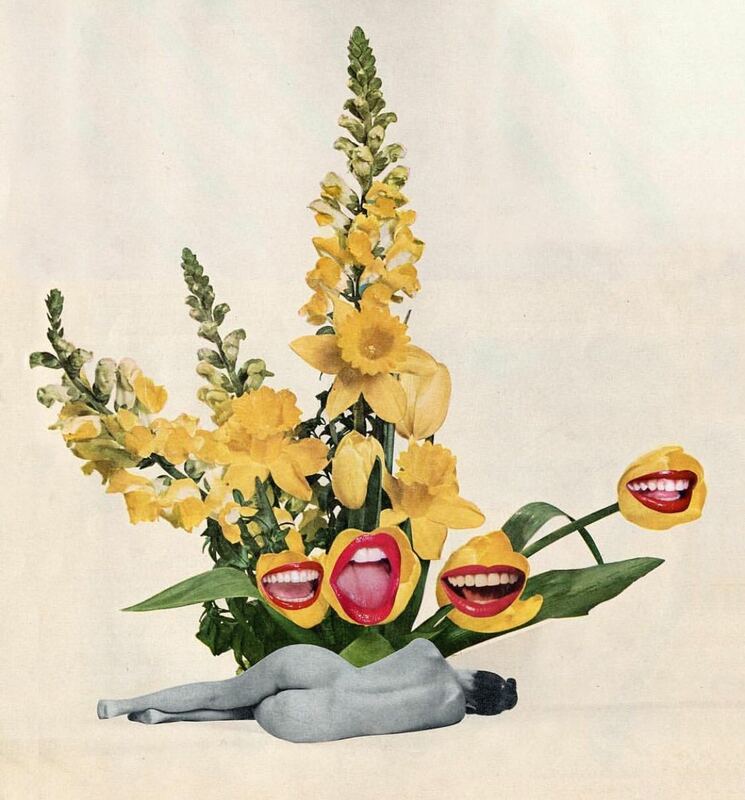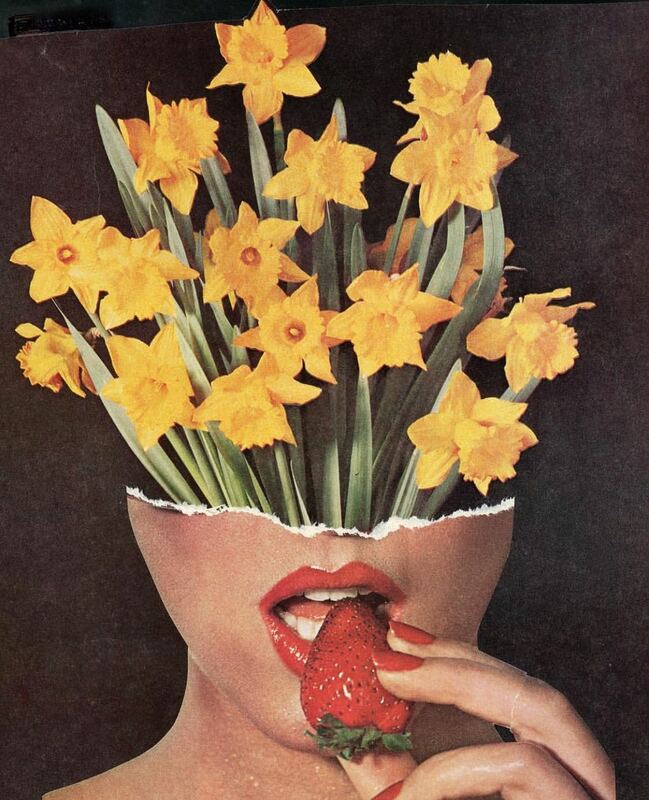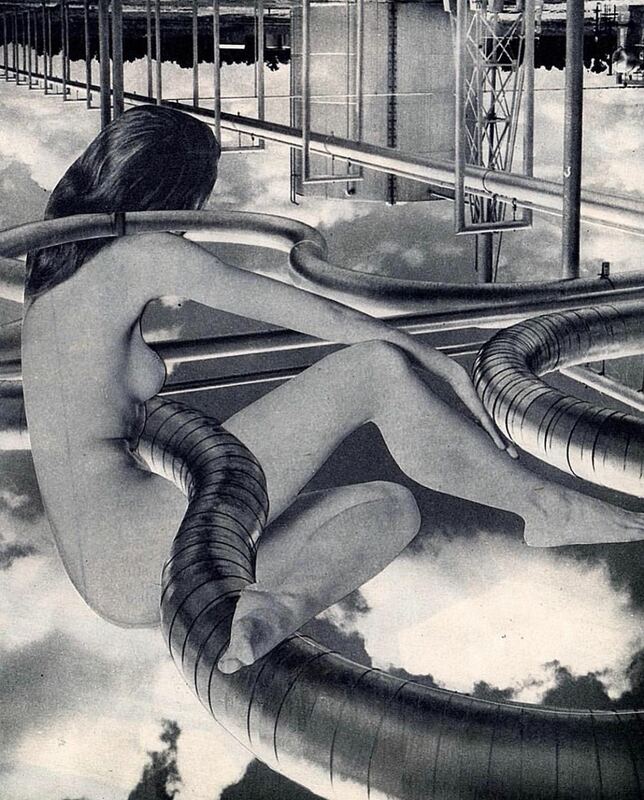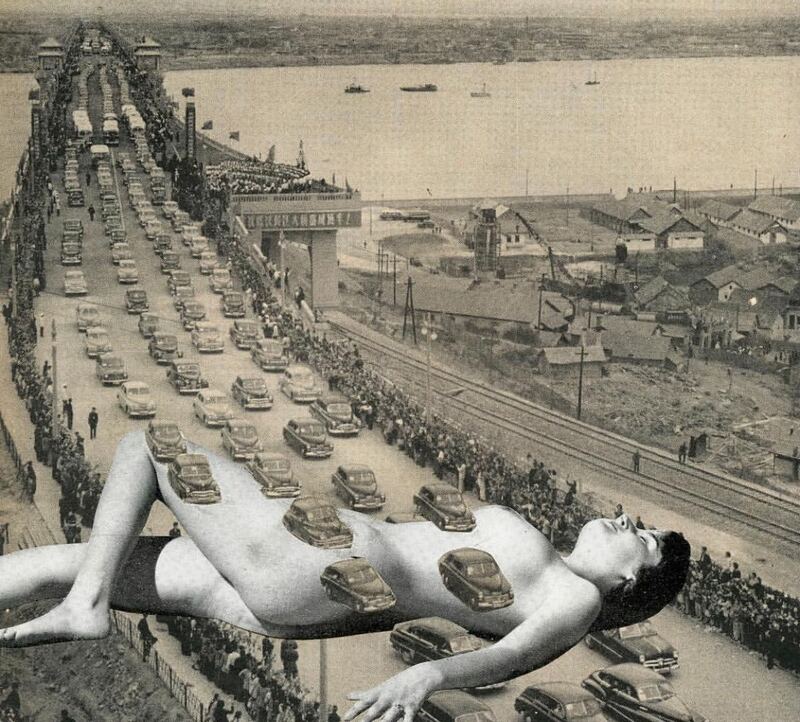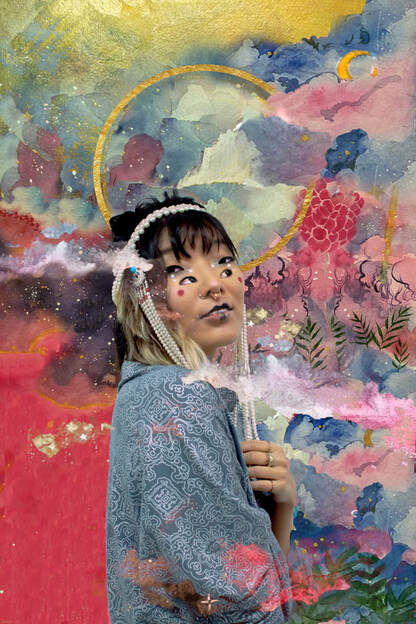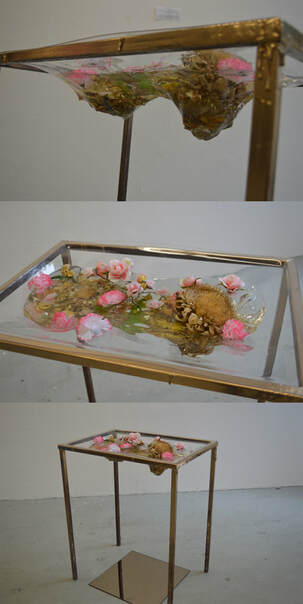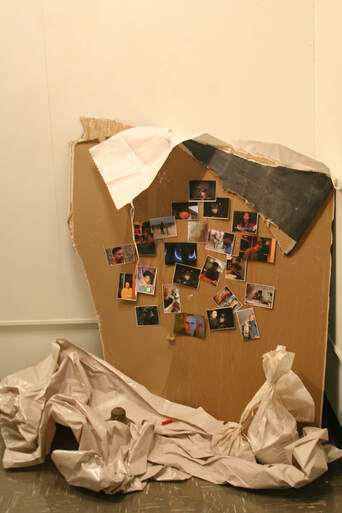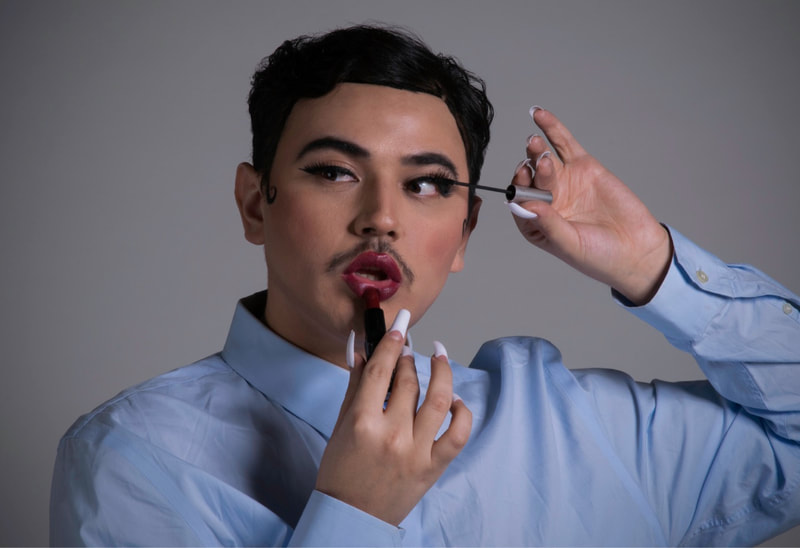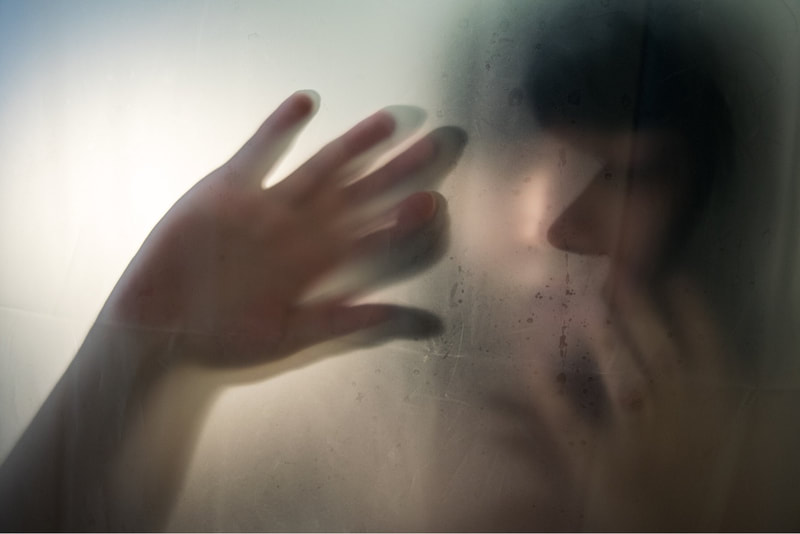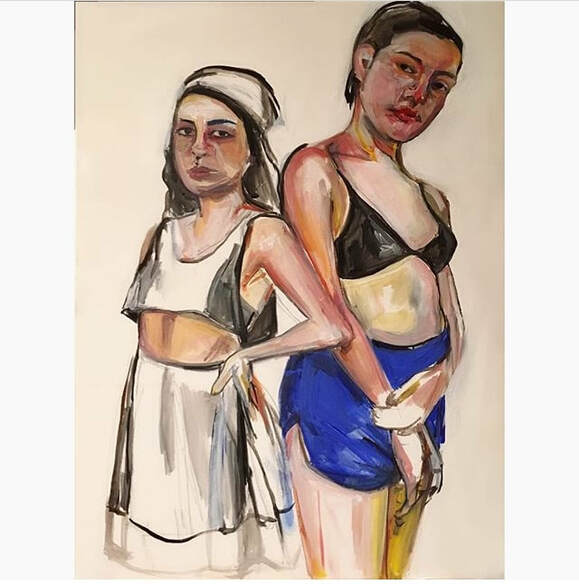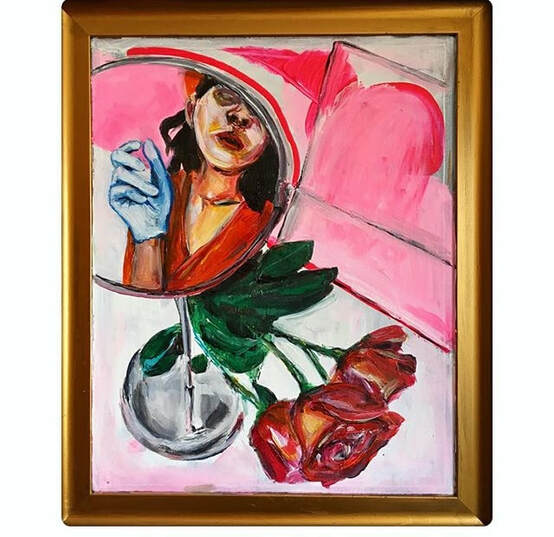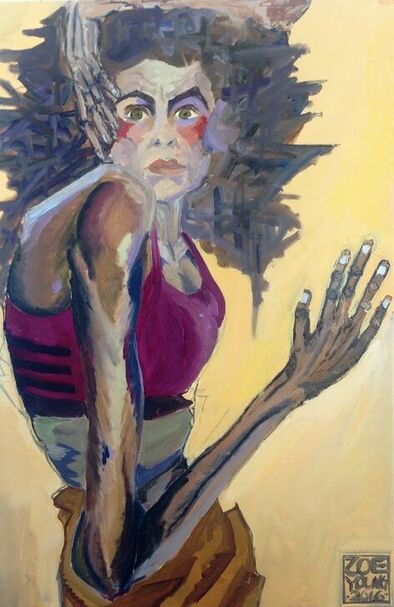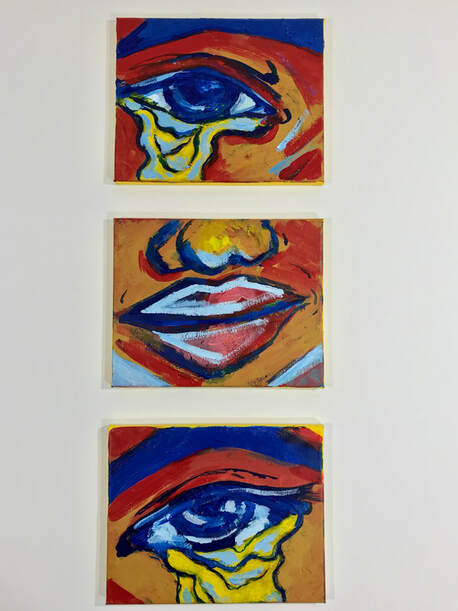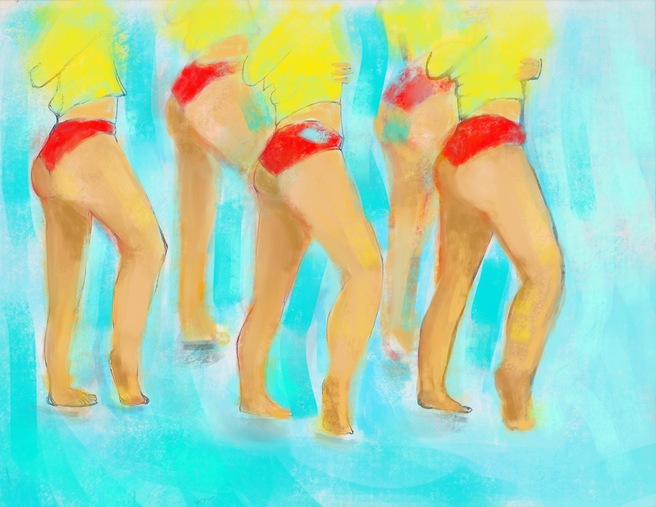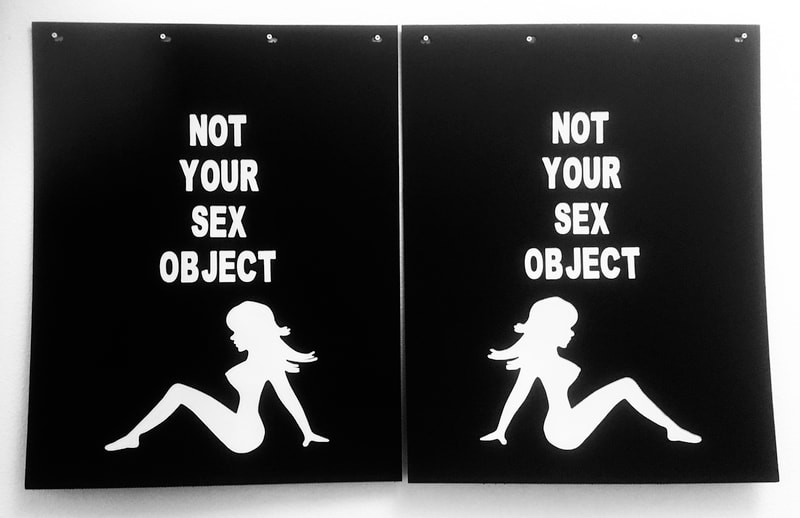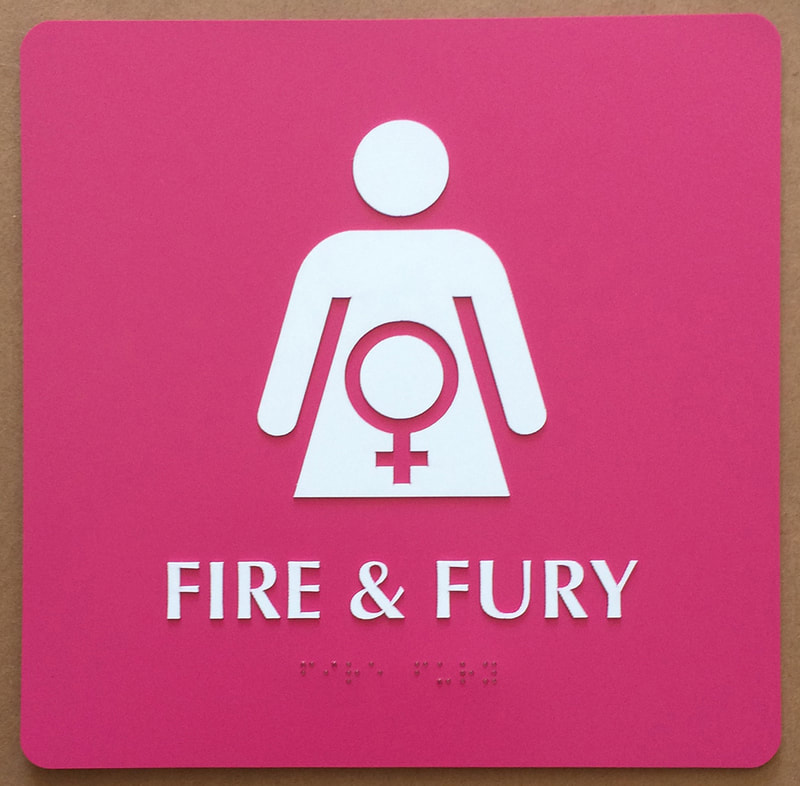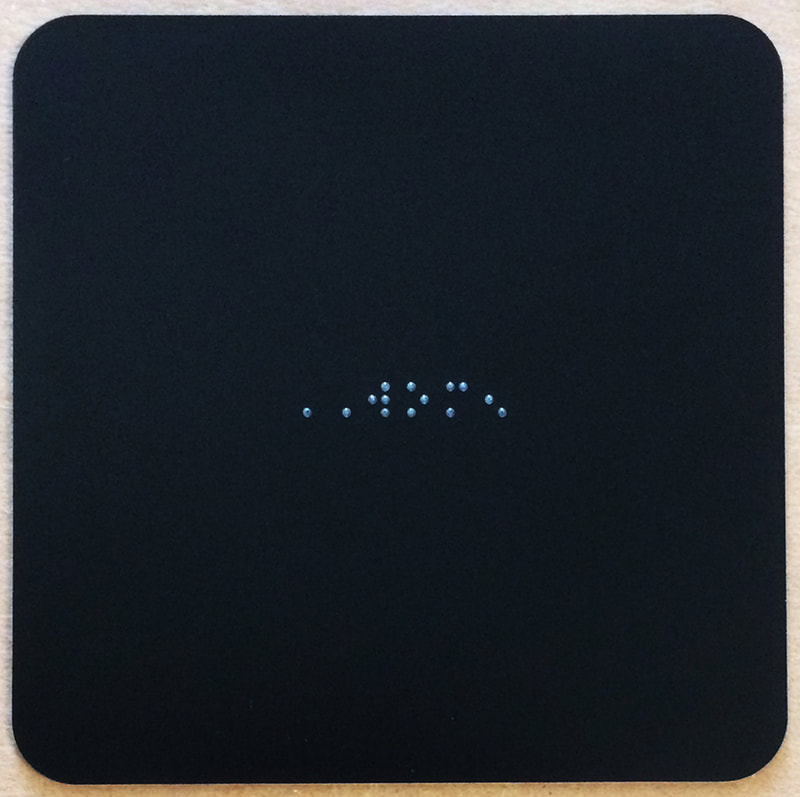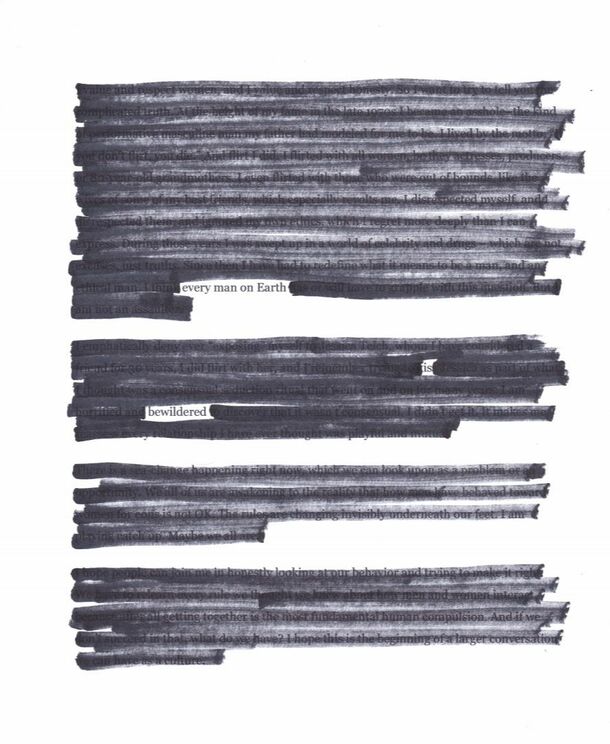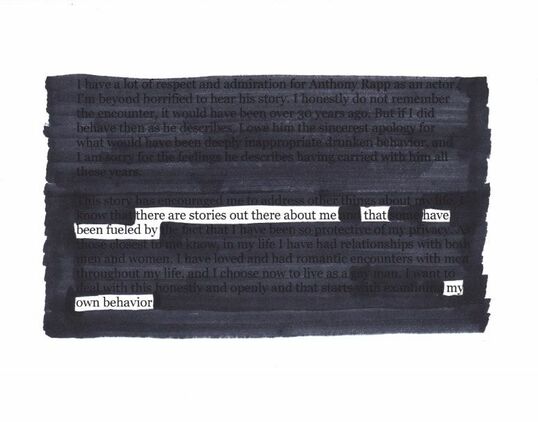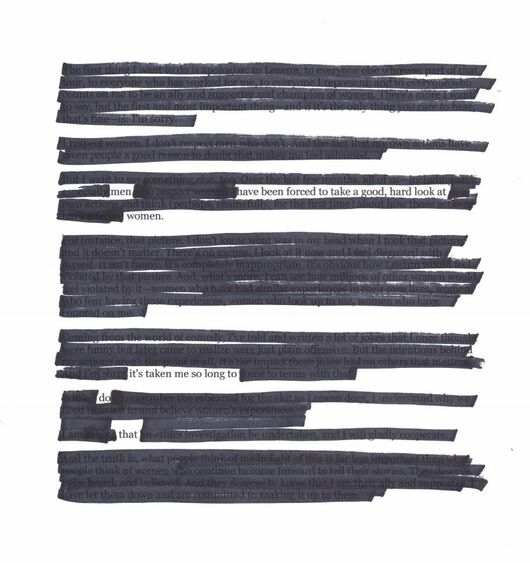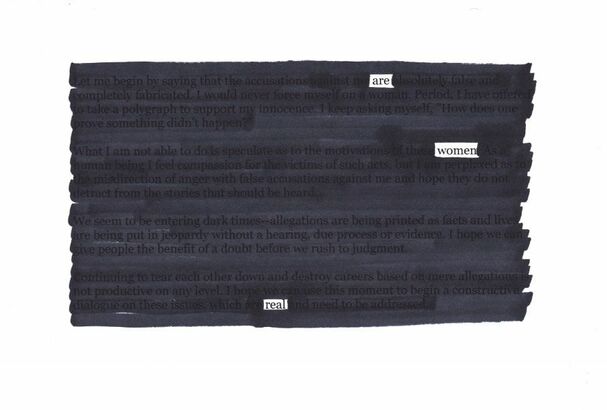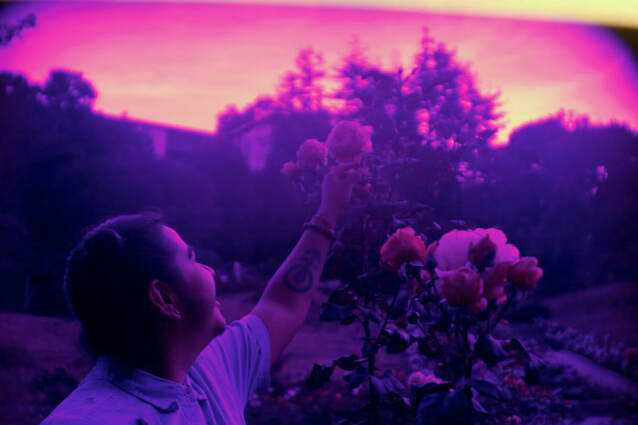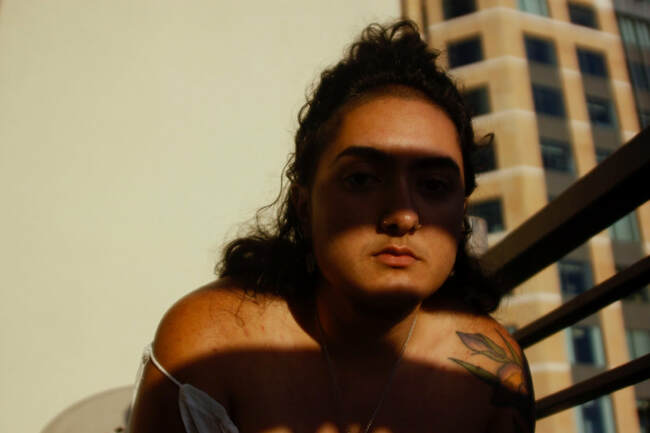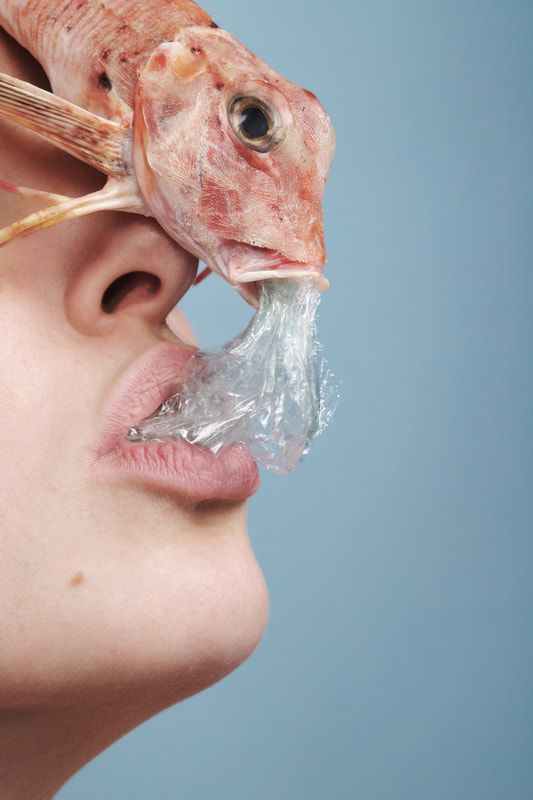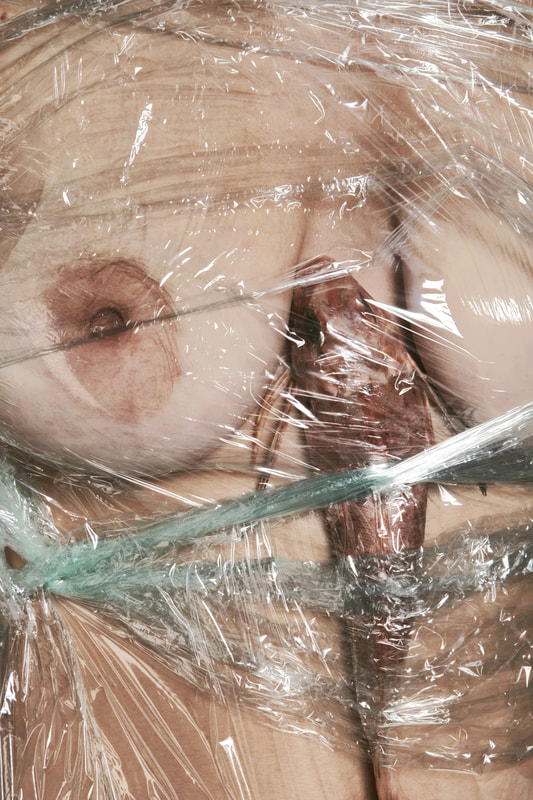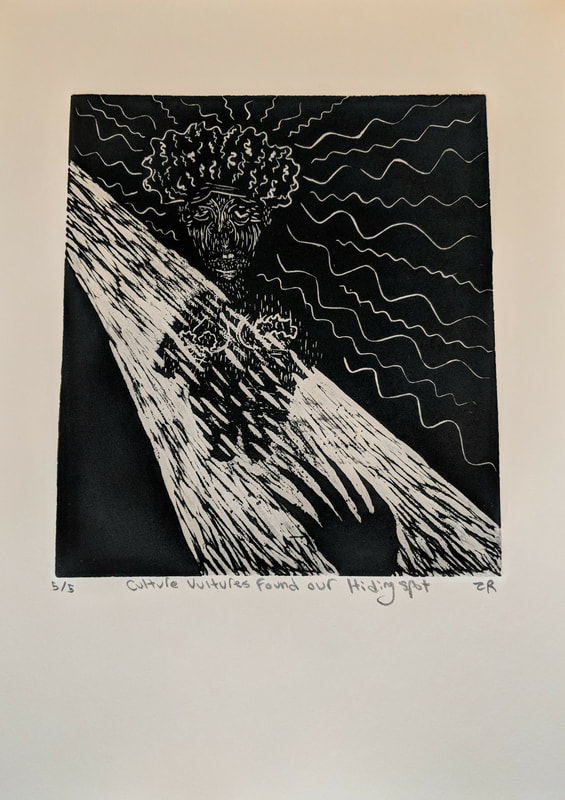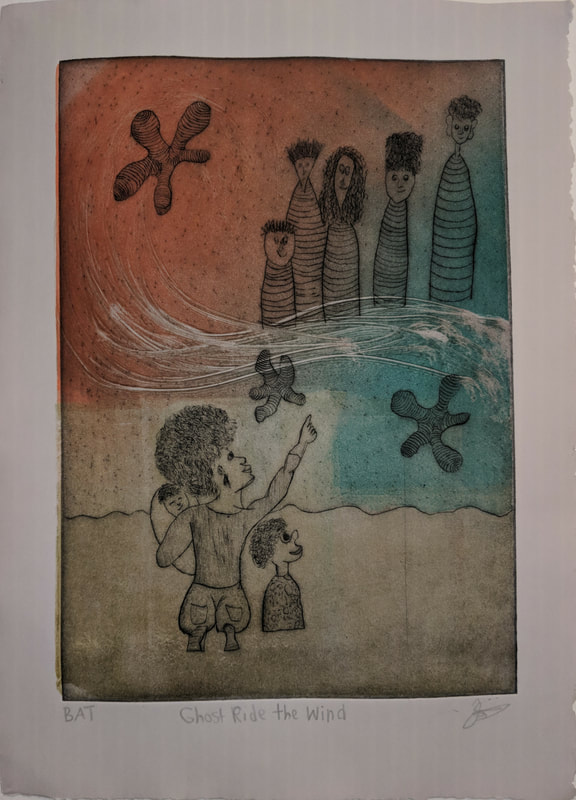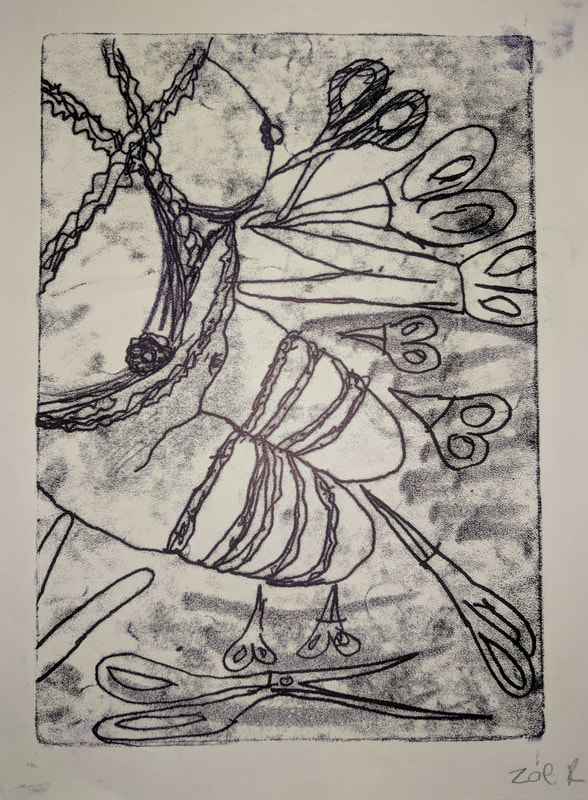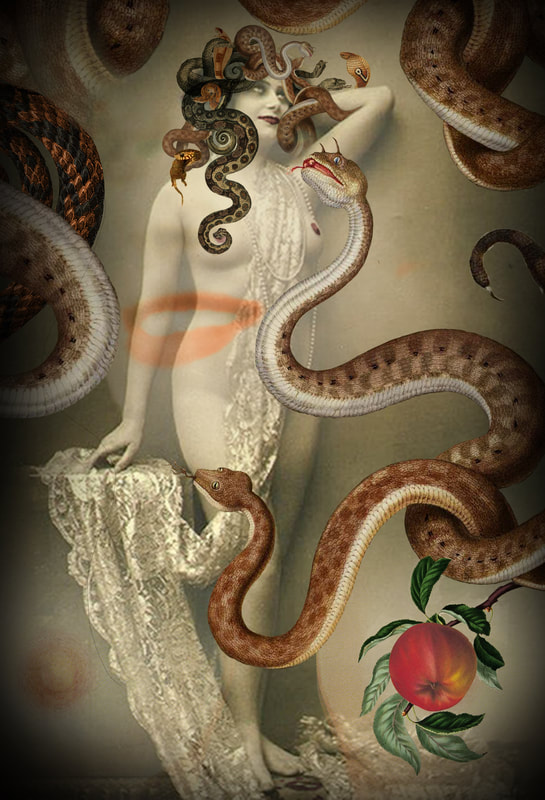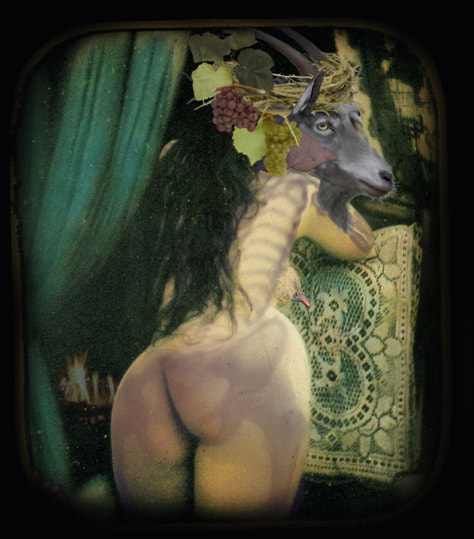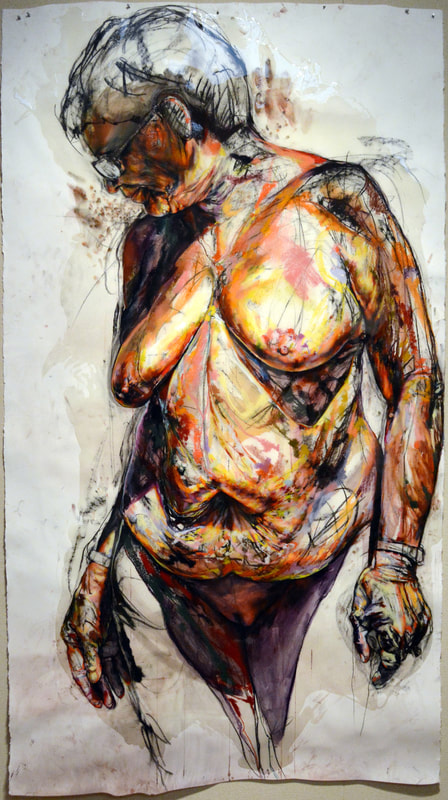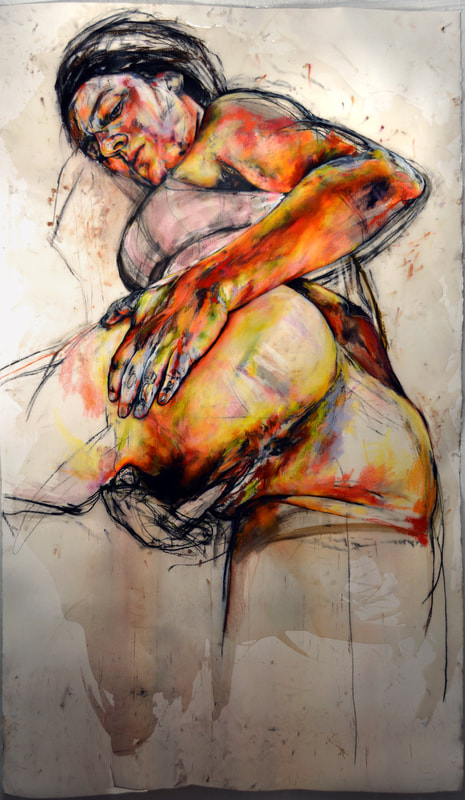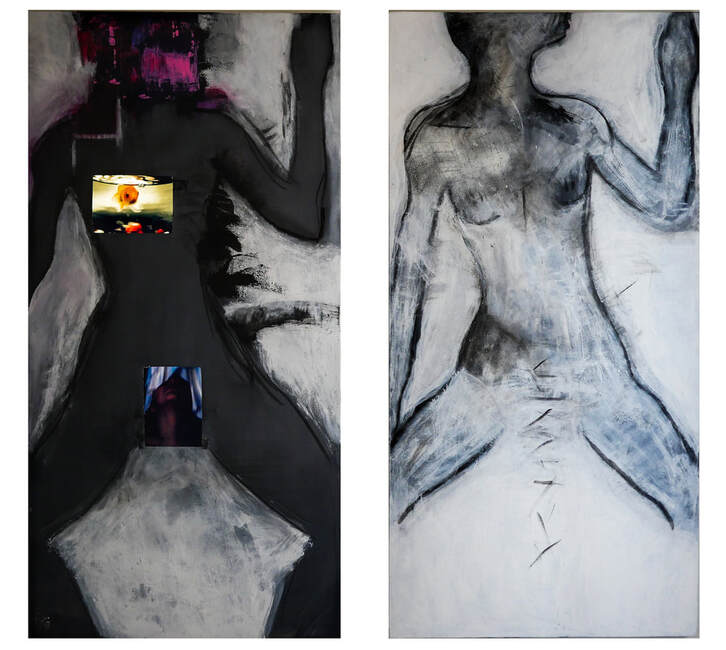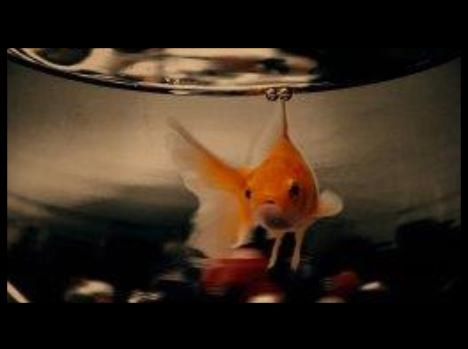EvE: Empowerment vs. Exploitation
A production of the non-profit: Tea Roots
Tea Roots presents the online exhibition EvE: Empowerment vs. Exploitation, which accompanies the exhibition EvE at Warehouse 416 Gallery in Oakland California, on view from March 1-16, 2019.
Note from Roots Artist Registry: This exhibition is for mature audiences only. Viewer advised. For adults 18 years of age and older.
Featured Artist: Alexandra Mushinski
I Cannot Forget Who I Am, 2017
My Body Has Always Belonged Solely To Me, 2016
A Woven Communion (six pieces from series), 2018
(contact artist for prices)
After experiencing sexual and emotional trauma, our minds force us to separate physical sensation from our innermost emotions. Forgetting is an act of relief, but emotion builds in your tailbone until you can’t stand to ignore the weight of grief. I am still learning how to carry the experience of inherited and societal traumas inflicted on the feminine body, but lessen the burden through connection with others. As humans split into interwoven story lines of body and soul, our best hope is held in finding common strands felt between us.
Weaving is a process of meditation: through tangible creation I visualize emotions that cannot be articulated in words alone. Using the poetry of language and repetition in woven cloth, I rewrite my body to hold the weight of abuse and allow the pieces to exist separate from memory. Through storytelling we know we are not alone. Hope is all we have, and I carry hope in my back pocket when times are bleak and my heart is heavy. Hope is why I make artwork. Hope is why I write poetry. I want to spread hope into my community. A safer, better future is possible if we reach out and instigate change in society. I extend the possibility for tender\ transformation in communion.
Through separation and deconstruction of cloth that acted as witness to sexual and emotional trauma, I take the burden of memory and reform it into a beautiful reminder of personal growth. By handling reminders of my trauma and that of another being, I find change in myself as I exonerate the hurt of others. Emotional potency is infused into the new cloth creating a transmuted experience of power and ownership, a voice separate from sound, demanding to be acknowledged. Through communion we become a small part of something as big as the world, only this time, we know we are not alone in our suffering.
--Alexandra Mushinski
alexandramushinski@gmail.com
www.alexandramushinski.com
My Body Has Always Belonged Solely To Me, 2016
A Woven Communion (six pieces from series), 2018
(contact artist for prices)
After experiencing sexual and emotional trauma, our minds force us to separate physical sensation from our innermost emotions. Forgetting is an act of relief, but emotion builds in your tailbone until you can’t stand to ignore the weight of grief. I am still learning how to carry the experience of inherited and societal traumas inflicted on the feminine body, but lessen the burden through connection with others. As humans split into interwoven story lines of body and soul, our best hope is held in finding common strands felt between us.
Weaving is a process of meditation: through tangible creation I visualize emotions that cannot be articulated in words alone. Using the poetry of language and repetition in woven cloth, I rewrite my body to hold the weight of abuse and allow the pieces to exist separate from memory. Through storytelling we know we are not alone. Hope is all we have, and I carry hope in my back pocket when times are bleak and my heart is heavy. Hope is why I make artwork. Hope is why I write poetry. I want to spread hope into my community. A safer, better future is possible if we reach out and instigate change in society. I extend the possibility for tender\ transformation in communion.
Through separation and deconstruction of cloth that acted as witness to sexual and emotional trauma, I take the burden of memory and reform it into a beautiful reminder of personal growth. By handling reminders of my trauma and that of another being, I find change in myself as I exonerate the hurt of others. Emotional potency is infused into the new cloth creating a transmuted experience of power and ownership, a voice separate from sound, demanding to be acknowledged. Through communion we become a small part of something as big as the world, only this time, we know we are not alone in our suffering.
--Alexandra Mushinski
alexandramushinski@gmail.com
www.alexandramushinski.com
Featured Artist: Aishwarya Vardhana
Atmosphere, installation, digital projection
NFS (commissions can be negotiated)
Aishwarya Vardhana, a recent graduate of Stanford University, is a San Francisco based conceptual artist, poet and designer. Her multidisciplinary practice involves digital art, installation, drawing, sculpture, and photography. Her practice connects the south Asian anti-colonial struggle with new wave American resistance and explores concepts of de-territoriality, materialism, power, and language.
If you would like to support Aishwarya’s work please Venmo her at Aishwarya-Vardhana.
Find her work on Instagram @shweeze
Or on her website: https://avardhan.wixsite.com/shweeze
avardhana42@gmail.com
503-803-7392
Laurie Shapiro
The first piece I am submitting is from my series of "Yoni Flowers." Yoni is a word for female genitals, which also means a sacred space. "Yoni Flower #14" is the most recent in this series, and the prior flowers are sold or on display. I am also submitting a piece called "Warrior," which encompasses themes of female empowerment, struggle, healing, and determination. In addition, the last piece "Yoni flower #15" is a proposal to make a few smaller yoni flower pieces (about 16" x 16"). Ideally, I would like to make a series of three small yoni flowers for EvE.
My name is Laurie Shapiro. I am a 29 year old artist living in Los Angeles. Before living in LA, I lived in Oakland, CA for five years. I have a BFA from Carnegie Mellon University and studied abroad in Ankara Turkey. When I make art, I am in a form of active meditation: the focus is healing, love, connection, and understanding. Currently, I have installations on display in Chicago and Ohio. My work is regularly shown in LA and has been used in many collaborative projects, including fashion and TV. In addition, I have displayed my work throughout the USA, in Europe and the Middle East. For more information, please visit my website: www.LaurieShapiroArt.com
The first piece I am submitting is from my series of "Yoni Flowers." Yoni is a word for female genitals, which also means a sacred space. "Yoni Flower #14" is the most recent in this series, and the prior flowers are sold or on display. I am also submitting a piece called "Warrior," which encompasses themes of female empowerment, struggle, healing, and determination. In addition, the last piece "Yoni flower #15" is a proposal to make a few smaller yoni flower pieces (about 16" x 16"). Ideally, I would like to make a series of three small yoni flowers for EvE.
My name is Laurie Shapiro. I am a 29 year old artist living in Los Angeles. Before living in LA, I lived in Oakland, CA for five years. I have a BFA from Carnegie Mellon University and studied abroad in Ankara Turkey. When I make art, I am in a form of active meditation: the focus is healing, love, connection, and understanding. Currently, I have installations on display in Chicago and Ohio. My work is regularly shown in LA and has been used in many collaborative projects, including fashion and TV. In addition, I have displayed my work throughout the USA, in Europe and the Middle East. For more information, please visit my website: www.LaurieShapiroArt.com
Randy Babb
"Emancipation", "Black Girls Matter", "Cap", "Pencil, Pen, Colored Pencil"
NFS
My name Randy Babb. At the age of 16 I taught myself how to draw. My life was in chaos and this became my outlet to express the feelings that could not be place into words. I draw what I see and allow my imagination, based on my journey, to transform these images into the finished work.
The pieces. I wish to present to you, embody my struggle to exist within a nation not created for me. They depict the historic and present threat to me as a POC around the world. From the slave trade and Jim Crow to the War on Drugs and systematic mass incarceration, my images speak the volumes of oppression that I and POC's am forced to carry. My pieces also hold within them questions of historic and present issues of Rape, Child abuse, child slavery, murder,sexism, bigotry, racism, racial bias, discrimination, justice, fairness and reconstruction. If nothing else my images are graphic depictions of our history and the trauma POC have endured.
"Emancipation", "Black Girls Matter", "Cap", "Pencil, Pen, Colored Pencil"
NFS
My name Randy Babb. At the age of 16 I taught myself how to draw. My life was in chaos and this became my outlet to express the feelings that could not be place into words. I draw what I see and allow my imagination, based on my journey, to transform these images into the finished work.
The pieces. I wish to present to you, embody my struggle to exist within a nation not created for me. They depict the historic and present threat to me as a POC around the world. From the slave trade and Jim Crow to the War on Drugs and systematic mass incarceration, my images speak the volumes of oppression that I and POC's am forced to carry. My pieces also hold within them questions of historic and present issues of Rape, Child abuse, child slavery, murder,sexism, bigotry, racism, racial bias, discrimination, justice, fairness and reconstruction. If nothing else my images are graphic depictions of our history and the trauma POC have endured.
Mojgan Saberi
We Are One
Oil on Canvas
$3,500
As a woman I have always had to consider behaving a certain way to give the right impression so I would be considered respectful within the boundaries of what respect means in this society. I had to be careful not to laugh too loud, not to dress a certain way, not to dance the way I choose to, not to walk the way I walk, not to be free. I control and calculate every move that I make.
My paintings represent what I consider freedom, without calculation or boundaries. I like to think of a world that one day accepts any human being regardless of their gender or the way one can show and express love. Maybe that sounds like a dream, but it is one which I hope some day will turn into a reality.
Mojgan Saberi was born in Tehran Iran, she immigrated to the United States in 1983. She graduated from University of Texas at Arlington with a degree in Architecture and Urban Planning. Her inspiration for her art work comes from lucid poetry, nature's purity, and simplicity yet with complex relations to human interactions. She begins with metaphors and silhouettes from the images that form in her mind from different fragments in life which are then transferred onto her works of art. She likes to explore with objects in dreamlike contexts to create scenery and moods. Her childhood memories and the Eastern culture that she comes from plays a major role in her creative thought process and artwork, which is now interwoven with the culture she has adopted by living in the United States. Mojgan expresses her passion for nature and life in Photography, Painting and Glass fusing.
We Are One
Oil on Canvas
$3,500
As a woman I have always had to consider behaving a certain way to give the right impression so I would be considered respectful within the boundaries of what respect means in this society. I had to be careful not to laugh too loud, not to dress a certain way, not to dance the way I choose to, not to walk the way I walk, not to be free. I control and calculate every move that I make.
My paintings represent what I consider freedom, without calculation or boundaries. I like to think of a world that one day accepts any human being regardless of their gender or the way one can show and express love. Maybe that sounds like a dream, but it is one which I hope some day will turn into a reality.
Mojgan Saberi was born in Tehran Iran, she immigrated to the United States in 1983. She graduated from University of Texas at Arlington with a degree in Architecture and Urban Planning. Her inspiration for her art work comes from lucid poetry, nature's purity, and simplicity yet with complex relations to human interactions. She begins with metaphors and silhouettes from the images that form in her mind from different fragments in life which are then transferred onto her works of art. She likes to explore with objects in dreamlike contexts to create scenery and moods. Her childhood memories and the Eastern culture that she comes from plays a major role in her creative thought process and artwork, which is now interwoven with the culture she has adopted by living in the United States. Mojgan expresses her passion for nature and life in Photography, Painting and Glass fusing.
Janet Braun-Reinitz
(Installation)
LADIES WHO GO THERE! is an audience-interactive installation, a collaboration by Janet Braun-Reinitz (USA) and Sarah Maple (UK). It consists of wall text, clothes line, clothes pins, a selection of "ladies who go there" badges/buttons and one-of-a-kind collaged postcards. The instructions for viewer participants are laid out in the wall text (see below).
WALL TEXT:
LADIES WHO GO THERE!
FIRST, SELECT A POSTCARD.
REMOVE FROM THE CLOTHESLINE.
WRITE A MESSAGE ON THE BACK -- VERBAL OR VISUAL. DON'T BE SHY.
RETURN THE POSTCARD TO THE CLOTHES LINE WITH YOUR MESSAGE SHOWING.
TAKE A BADGE/BUTTON OF YOUR CHOOSING AS A THANK YOU FROM THE LADIES.
JANET BRAUN-REINITZ and SARAH MAPLE
ARTISTS ARE HERE TO DISTURB THE PEACE.
Postcards:
Each postcard is usually collaged first, often with a printed text, typically from a newspaper or magazine, but occasionally from other sources including telephone books, government documents and maps. Many, but not all, are in English. These background texts may or may not be relevant to the overall subject of the postcard. Collaged or painted elements are then layered on the background. The subjects of the added materials vary widely. Most are political, addressing pressing contemporary national and international social justice issues (including racism, sexism, disasters, immigration, war et al.) while others are quite simply humorous. Many include added texts (sometimes almost hidden) or signage as well as pop culture and art history references.
The postcards measure 9" long by 4" high and can be clipped to the clothes line horizontally (preferred) or vertically.
LADIES WHO GO THERE! has three primary goals. The first is to create a situation - inside or outside of traditional art venues - where a large and diverse audience can publicly participate in sharing ideas. We want to subvert the idea that the viewing of art is an elitist activity beyond the reach of most people. While an installation can and will certainly be shown in the usual venues, we hope that it will find its way to less traditional and even surprising sites as well that we have yet to imagine. Like the venues themselves, the length of time and size of an installation is will vary. The second goal is to offer a wide range of possible subjects and aesthetics from which to select. Most have an underlying social justice critique, contemporary and/or historical, though some are quite simply designed to solicit a smile. The third goal is to create a genuine experience where the participants' commentary on the process -- or anything else they may choose to note - are valued and shared with other viewers and ultimately with the artists, creating a conversation both in real time and across the length of the installation.
Janet Braun-Reinitz
Artists are here to disturb the peace.
I am a painter, muralist and activist. Since 1984 I have collaborated in painting more than fifty community murals in NYC, elsewhere in the USA and in seven international locations. My work has been widely exhibited, most recently in a solo exhibition, "Troubled Waters", Spazio Bocciofila, Venice, Italy, 2016, "Ladies Who Go There"; Fabulon Gallery, Charleston, SC, 2017 and University of South Dakota, Vermillion, 2018. Whatever the size of my work, from large scale hanging banners and murals to small books, it is always my hope that viewers will enter a dialog -- internally or with others -- on how to think their way through the provocation of images.
My studio work is in collections as diverse as the Rock and Roll Hall of Fame and Museum, Oakland Museum of CA, Bristol-Myers Corporation, NYC, PAD/D Archives, MOMA. In addition, I have twice been the recipient of "Anonymous", a grant for the creation of political art (2014 and 2009), as well as other grants and prizes and am the co-author of On The Wall: Four Decades of Community Murals in New York City. My mural work has been chronicled in several documentary films including Beyond the Walls, Gail Embrey, Power Surge Productions, 2014, La Grande Jatte in Harlem, Directed and Edited by Thomas W. Campbell , 2013 , and The Women of Nostrand and Greene, Dave Reinitz, H2F Productions, 2006.
(Installation)
LADIES WHO GO THERE! is an audience-interactive installation, a collaboration by Janet Braun-Reinitz (USA) and Sarah Maple (UK). It consists of wall text, clothes line, clothes pins, a selection of "ladies who go there" badges/buttons and one-of-a-kind collaged postcards. The instructions for viewer participants are laid out in the wall text (see below).
WALL TEXT:
LADIES WHO GO THERE!
FIRST, SELECT A POSTCARD.
REMOVE FROM THE CLOTHESLINE.
WRITE A MESSAGE ON THE BACK -- VERBAL OR VISUAL. DON'T BE SHY.
RETURN THE POSTCARD TO THE CLOTHES LINE WITH YOUR MESSAGE SHOWING.
TAKE A BADGE/BUTTON OF YOUR CHOOSING AS A THANK YOU FROM THE LADIES.
JANET BRAUN-REINITZ and SARAH MAPLE
ARTISTS ARE HERE TO DISTURB THE PEACE.
Postcards:
Each postcard is usually collaged first, often with a printed text, typically from a newspaper or magazine, but occasionally from other sources including telephone books, government documents and maps. Many, but not all, are in English. These background texts may or may not be relevant to the overall subject of the postcard. Collaged or painted elements are then layered on the background. The subjects of the added materials vary widely. Most are political, addressing pressing contemporary national and international social justice issues (including racism, sexism, disasters, immigration, war et al.) while others are quite simply humorous. Many include added texts (sometimes almost hidden) or signage as well as pop culture and art history references.
The postcards measure 9" long by 4" high and can be clipped to the clothes line horizontally (preferred) or vertically.
LADIES WHO GO THERE! has three primary goals. The first is to create a situation - inside or outside of traditional art venues - where a large and diverse audience can publicly participate in sharing ideas. We want to subvert the idea that the viewing of art is an elitist activity beyond the reach of most people. While an installation can and will certainly be shown in the usual venues, we hope that it will find its way to less traditional and even surprising sites as well that we have yet to imagine. Like the venues themselves, the length of time and size of an installation is will vary. The second goal is to offer a wide range of possible subjects and aesthetics from which to select. Most have an underlying social justice critique, contemporary and/or historical, though some are quite simply designed to solicit a smile. The third goal is to create a genuine experience where the participants' commentary on the process -- or anything else they may choose to note - are valued and shared with other viewers and ultimately with the artists, creating a conversation both in real time and across the length of the installation.
Janet Braun-Reinitz
Artists are here to disturb the peace.
I am a painter, muralist and activist. Since 1984 I have collaborated in painting more than fifty community murals in NYC, elsewhere in the USA and in seven international locations. My work has been widely exhibited, most recently in a solo exhibition, "Troubled Waters", Spazio Bocciofila, Venice, Italy, 2016, "Ladies Who Go There"; Fabulon Gallery, Charleston, SC, 2017 and University of South Dakota, Vermillion, 2018. Whatever the size of my work, from large scale hanging banners and murals to small books, it is always my hope that viewers will enter a dialog -- internally or with others -- on how to think their way through the provocation of images.
My studio work is in collections as diverse as the Rock and Roll Hall of Fame and Museum, Oakland Museum of CA, Bristol-Myers Corporation, NYC, PAD/D Archives, MOMA. In addition, I have twice been the recipient of "Anonymous", a grant for the creation of political art (2014 and 2009), as well as other grants and prizes and am the co-author of On The Wall: Four Decades of Community Murals in New York City. My mural work has been chronicled in several documentary films including Beyond the Walls, Gail Embrey, Power Surge Productions, 2014, La Grande Jatte in Harlem, Directed and Edited by Thomas W. Campbell , 2013 , and The Women of Nostrand and Greene, Dave Reinitz, H2F Productions, 2006.
Maya Chan
"Within the Skin"
Digitally Modified Self Portraits
$75 each
I am a femme, Asian American artist. This three part photo series entitled "Within the Skin" the digitally modified works are self portraits with both reductive uncovering and additive layering in a process akin to scarring or tattooing. This artwork commemorates both the presence and absence of the stories of Chinese womxn systematically rendered invisible throughout hxtory, and the far-reaching power of the patriarchy and oppression to define hxstory by what is seen, unseen, forgotten and remembered. The central self portrait is my ancestral village crosscut and printed upon the skin, as a cross-generational portrait of womxnhood. As an exploration of a cross-generational identity of womxnhood, this three-part photo series deconstructs conventions of self-portraiture through its visualization of erasure and its exploration of the ways in which traces of the past are omnipresent in every facet of the present.
Maya Chan is a dynamic, multi-disciplinary artist in Berkeley, CA. Born and raised in the Bay Area, Chan is a third-year student at UC Berkeley double majoring in Art Practice and Ethnic Studies. Chan utilizes collage, painting, photography, and digital media in her practice, and she has exhibited at various art shows throughout the East Bay. Early influences in Maya Chan''s art practice come from her child experiences of watching her grandmother creating Chinese ink paintings and learning from the murals and street art culture in Oakland and SF. A second generation, Chinese American artist, Chan's most recent and ongoing works draw inspiration from practices of commemoration, spirituality, and ancestral worship. As explorations into the chaotic nature of the emotional psyche and human memory, Chan work explores the ways in which creation takes place through cycles of destruction and reorganization.
"Within the Skin"
Digitally Modified Self Portraits
$75 each
I am a femme, Asian American artist. This three part photo series entitled "Within the Skin" the digitally modified works are self portraits with both reductive uncovering and additive layering in a process akin to scarring or tattooing. This artwork commemorates both the presence and absence of the stories of Chinese womxn systematically rendered invisible throughout hxtory, and the far-reaching power of the patriarchy and oppression to define hxstory by what is seen, unseen, forgotten and remembered. The central self portrait is my ancestral village crosscut and printed upon the skin, as a cross-generational portrait of womxnhood. As an exploration of a cross-generational identity of womxnhood, this three-part photo series deconstructs conventions of self-portraiture through its visualization of erasure and its exploration of the ways in which traces of the past are omnipresent in every facet of the present.
Maya Chan is a dynamic, multi-disciplinary artist in Berkeley, CA. Born and raised in the Bay Area, Chan is a third-year student at UC Berkeley double majoring in Art Practice and Ethnic Studies. Chan utilizes collage, painting, photography, and digital media in her practice, and she has exhibited at various art shows throughout the East Bay. Early influences in Maya Chan''s art practice come from her child experiences of watching her grandmother creating Chinese ink paintings and learning from the murals and street art culture in Oakland and SF. A second generation, Chinese American artist, Chan's most recent and ongoing works draw inspiration from practices of commemoration, spirituality, and ancestral worship. As explorations into the chaotic nature of the emotional psyche and human memory, Chan work explores the ways in which creation takes place through cycles of destruction and reorganization.
Helena Busansky
"Luxury Tax" and "Untitled (Ghosts)"
Tampons, Acrylic Paint, Wood, Beads, Fabric
Fabric, Metal Hangers, Bed Frame
$350, NFS
As I've gotten older, the issues of sexual assault and harassment have taken a priority in my life. I cannot remember a time when little girls (and many little boys) have not been sexualized: ever since I was quite young (in fact as long as I can remember) while walking down the street, most of my friends and I have been subjected to catcalling and other sexualizations of our bodies. The tacit normality of this culture of harassment has manifested itself in my life more often as I've gotten older, and the makings and results of sexual assault are everywhere I look. From the halls of Berkeley High to parties, to the news -- sexual harassment and assault are everywhere, profoundly affecting and stunting both me and many others I know.
My pieces look at the culture and reality of sexual assault. I explore the fact that in every stage of life, women and girls are subject to harassment. I have tried to explore this ever-pervasive part of life as a woman.
It is clear that gender-based discrimination and oppression are deeply ingrained in the government, media, and culture. However, the systematic and societal challenges women face motivates my art, and I intend to inspire opportunities for reflection and empowerment. I believe that people who identify as female will be instrumental in creating the change America so desperately needs.
Artist Statement:
Of all the world's cultural opportunities, the visual arts and politics have been the most meaningful to me. In many ways, I have my grandmothers to thank for this. My grandmother Helen was a painter and a groundbreaking sex therapist. My grandmother Phyllis devoted her life to helping others and ran for Congress twice (I remember campaigning for her with my sisters and holding signs up in the street when we were barely big enough to carry them by ourselves). Due to their influence, I have always been passionate about political activism, art, and gender equality. But, it was not until high school that I realized a way to combine all three of my interests. My deeper understanding of the cultural impact of art was galvanized by a meme--a cartoon clenched fist with the caption: "When you realize, historically, embroidery hasn't been taken seriously because it's women's work." I realized that traditionally feminine mediums, such as sewing and quilting, have been trivialized by society. I saw how art reflects contemporary culture and how strongly these cultural attitudes had influenced me. I am inspired by trailblazing female artists who have had their art ignored, passed over, and devalued because of their gender, race, or sexual orientation. While I cannot claim many of their struggles, I have been profoundly influenced by the beautiful artwork that is overlooked by the mainstream art world. I now seek to embrace art as a tool to effect positive cultural change.
"Luxury Tax" and "Untitled (Ghosts)"
Tampons, Acrylic Paint, Wood, Beads, Fabric
Fabric, Metal Hangers, Bed Frame
$350, NFS
As I've gotten older, the issues of sexual assault and harassment have taken a priority in my life. I cannot remember a time when little girls (and many little boys) have not been sexualized: ever since I was quite young (in fact as long as I can remember) while walking down the street, most of my friends and I have been subjected to catcalling and other sexualizations of our bodies. The tacit normality of this culture of harassment has manifested itself in my life more often as I've gotten older, and the makings and results of sexual assault are everywhere I look. From the halls of Berkeley High to parties, to the news -- sexual harassment and assault are everywhere, profoundly affecting and stunting both me and many others I know.
My pieces look at the culture and reality of sexual assault. I explore the fact that in every stage of life, women and girls are subject to harassment. I have tried to explore this ever-pervasive part of life as a woman.
It is clear that gender-based discrimination and oppression are deeply ingrained in the government, media, and culture. However, the systematic and societal challenges women face motivates my art, and I intend to inspire opportunities for reflection and empowerment. I believe that people who identify as female will be instrumental in creating the change America so desperately needs.
Artist Statement:
Of all the world's cultural opportunities, the visual arts and politics have been the most meaningful to me. In many ways, I have my grandmothers to thank for this. My grandmother Helen was a painter and a groundbreaking sex therapist. My grandmother Phyllis devoted her life to helping others and ran for Congress twice (I remember campaigning for her with my sisters and holding signs up in the street when we were barely big enough to carry them by ourselves). Due to their influence, I have always been passionate about political activism, art, and gender equality. But, it was not until high school that I realized a way to combine all three of my interests. My deeper understanding of the cultural impact of art was galvanized by a meme--a cartoon clenched fist with the caption: "When you realize, historically, embroidery hasn't been taken seriously because it's women's work." I realized that traditionally feminine mediums, such as sewing and quilting, have been trivialized by society. I saw how art reflects contemporary culture and how strongly these cultural attitudes had influenced me. I am inspired by trailblazing female artists who have had their art ignored, passed over, and devalued because of their gender, race, or sexual orientation. While I cannot claim many of their struggles, I have been profoundly influenced by the beautiful artwork that is overlooked by the mainstream art world. I now seek to embrace art as a tool to effect positive cultural change.
Melanie Lombard
"Dissolve" "Nest3" and "Phenom"
Watercolor, salt, and graphite on paper
$300, $250, $300
I've lived in Alaska for most of my life, and my work is heavily influenced by the natural world. My connection to nature is where I find my spirituality. Spirituality, gender, and nature are all themes that I explore in my work, and I see a significant connection between the patriarchal exploitation of women and the destruction of the earth. I feel an urgency to make work about nature and spirituality that is intentionally feminine. I think of the images I've submitted as cosmic wombs, as places of infinite possibility. They are also the colors of the Alaskan landscape in winter, and have the subtle sparkle of snow. This work is an expression of my devotion to nature and place, as well as my own personal exploration of the divine feminine- and so these images are meant to look like nests, wombs and atoms, and sometimes are suggestive of cis female genitalia.
I like to think that making art is a human continuation of nature's creative process, and I often try to mimic different natural processes while making my work. I leave a lot up to chance and rely on the unpredictable and mutable nature of water. Many of my watercolor washes are done in such a way that the results are totally unexpected and impossible to reproduce. Regardless of the medium, I am interested in creating abstract or semi-abstract organic forms that appear to be in transition, whether they are on their way to becoming something else or they simply appear to be many different things. I always follow themes of transformation, particularly birth and death, which many spiritual traditions associate with the idea of the divine feminine. I strongly believe that female empowerment can be a spiritual experience- one that is not only about external identity, but is also an internal, contemplative process of fully becoming oneself. Through this internal process we can discover our connection to the natural world, which is a necessary paradigm shift towards healing the earth.
"Dissolve" "Nest3" and "Phenom"
Watercolor, salt, and graphite on paper
$300, $250, $300
I've lived in Alaska for most of my life, and my work is heavily influenced by the natural world. My connection to nature is where I find my spirituality. Spirituality, gender, and nature are all themes that I explore in my work, and I see a significant connection between the patriarchal exploitation of women and the destruction of the earth. I feel an urgency to make work about nature and spirituality that is intentionally feminine. I think of the images I've submitted as cosmic wombs, as places of infinite possibility. They are also the colors of the Alaskan landscape in winter, and have the subtle sparkle of snow. This work is an expression of my devotion to nature and place, as well as my own personal exploration of the divine feminine- and so these images are meant to look like nests, wombs and atoms, and sometimes are suggestive of cis female genitalia.
I like to think that making art is a human continuation of nature's creative process, and I often try to mimic different natural processes while making my work. I leave a lot up to chance and rely on the unpredictable and mutable nature of water. Many of my watercolor washes are done in such a way that the results are totally unexpected and impossible to reproduce. Regardless of the medium, I am interested in creating abstract or semi-abstract organic forms that appear to be in transition, whether they are on their way to becoming something else or they simply appear to be many different things. I always follow themes of transformation, particularly birth and death, which many spiritual traditions associate with the idea of the divine feminine. I strongly believe that female empowerment can be a spiritual experience- one that is not only about external identity, but is also an internal, contemplative process of fully becoming oneself. Through this internal process we can discover our connection to the natural world, which is a necessary paradigm shift towards healing the earth.
Cat Sommer
"From Bogotá to Los Angeles""Wrapped in My Love" and "When Pattern Meets Air"
Acrylic on canvas
$900, $700, $900
Painting is a way of reworking, refiguring. It is not a mirror held up to the world but a field where I can place elements together and let them push against, bend, reimagine themselves. My paintings are a visual social diary: thinking done outside the burden of language, and beyond its limits.
My work constantly returns to identity: a word that in its limits manages to encompass both a system for categorizing others (labels pressed from the outside) and a means of aligning oneself (a site of agency). It encompasses notions of gender, culture, race, sexuality. If my work must mark a point as its center, it is this word, but it is only because I am interested in creating work that celebrates the relationship between people and what I call the human spirit, and all of the cultural norms and constructs such a spirit must navigate.
I paint portraits. I paint people intimate to me, people I know and want to understand, their untold stories. I wonder how to work in portraiture without objectifying. How to portray subtleties when our vision has been trained to flatten. I bring to each of these portraits my own history and set of concerns: a lens of complexity, of my own ever-changing identity:
I was born to a Colombian mother and American father. Raised in California in the 80's, I wonder: How Latina am I? How American? Ask an American and I am Colombian American. Ask a person on the street in Bogotá and I am American. As a child I was encouraged to assimilate.
I am now a mother in San Francisco. Motherhood is a central theme in my work because it has been a central theme in my life. It is written on to me with my gender. The adornment of my infant body (earrings, rings, lace dresses...), its treatment as a trophy, was both a reflection of the prize of motherhood and the start of my gender-marking.
Through my painting, I want to challenge my own conceptions of identity, gender, race, culture, and to discover in them the force of change, the fluidity of reality. My portraits are overrun with flora and fauna. I pair solitary men with the sweet animals that adore them. Men are also victim to social norms, but not all fit perfectly into our molds. These are the men I find most interesting. I want to create a visual palette that neutralizes gender and celebrates relationships regardless of sex or race. Plant and animal imagery can be read as "'feminine" and I embrace this, as both a celebration of my identity and as a destabilizing force in my work; in its action against other objects it encounters (branches become skin, flowers become eyes) in addition to the power one wields in embracing a "pejorative" the ""girly."
My work "a visual social diary"' is a place for defying dangerous cultural norms, imagining alternatives, and embracing fluidity as a working model for understanding the world. Portraying a beautiful, strong woman without objectifying. Working through the expectations of a Latin woman in a feminist age. Facing biracial and cultural norms in the United States without devaluing heritage, history. Parsing out biracial dynamics in the home, especially as they relate to motherhood. Accessing my unconscious, visualizing emotion, making tangible the human spirit and histories. Reworking, refiguring, reimagining.
Artist Bio
Cat Sommer is an American artist born in Torrance, California, to a Colombian woman and an American man. She earned a Bachelor of Fine Arts in Studio Art, a Gender Studies Theme, and a minor in Art History from California State University, Chico.
She currently works in San Francisco, California.
"From Bogotá to Los Angeles""Wrapped in My Love" and "When Pattern Meets Air"
Acrylic on canvas
$900, $700, $900
Painting is a way of reworking, refiguring. It is not a mirror held up to the world but a field where I can place elements together and let them push against, bend, reimagine themselves. My paintings are a visual social diary: thinking done outside the burden of language, and beyond its limits.
My work constantly returns to identity: a word that in its limits manages to encompass both a system for categorizing others (labels pressed from the outside) and a means of aligning oneself (a site of agency). It encompasses notions of gender, culture, race, sexuality. If my work must mark a point as its center, it is this word, but it is only because I am interested in creating work that celebrates the relationship between people and what I call the human spirit, and all of the cultural norms and constructs such a spirit must navigate.
I paint portraits. I paint people intimate to me, people I know and want to understand, their untold stories. I wonder how to work in portraiture without objectifying. How to portray subtleties when our vision has been trained to flatten. I bring to each of these portraits my own history and set of concerns: a lens of complexity, of my own ever-changing identity:
I was born to a Colombian mother and American father. Raised in California in the 80's, I wonder: How Latina am I? How American? Ask an American and I am Colombian American. Ask a person on the street in Bogotá and I am American. As a child I was encouraged to assimilate.
I am now a mother in San Francisco. Motherhood is a central theme in my work because it has been a central theme in my life. It is written on to me with my gender. The adornment of my infant body (earrings, rings, lace dresses...), its treatment as a trophy, was both a reflection of the prize of motherhood and the start of my gender-marking.
Through my painting, I want to challenge my own conceptions of identity, gender, race, culture, and to discover in them the force of change, the fluidity of reality. My portraits are overrun with flora and fauna. I pair solitary men with the sweet animals that adore them. Men are also victim to social norms, but not all fit perfectly into our molds. These are the men I find most interesting. I want to create a visual palette that neutralizes gender and celebrates relationships regardless of sex or race. Plant and animal imagery can be read as "'feminine" and I embrace this, as both a celebration of my identity and as a destabilizing force in my work; in its action against other objects it encounters (branches become skin, flowers become eyes) in addition to the power one wields in embracing a "pejorative" the ""girly."
My work "a visual social diary"' is a place for defying dangerous cultural norms, imagining alternatives, and embracing fluidity as a working model for understanding the world. Portraying a beautiful, strong woman without objectifying. Working through the expectations of a Latin woman in a feminist age. Facing biracial and cultural norms in the United States without devaluing heritage, history. Parsing out biracial dynamics in the home, especially as they relate to motherhood. Accessing my unconscious, visualizing emotion, making tangible the human spirit and histories. Reworking, refiguring, reimagining.
Artist Bio
Cat Sommer is an American artist born in Torrance, California, to a Colombian woman and an American man. She earned a Bachelor of Fine Arts in Studio Art, a Gender Studies Theme, and a minor in Art History from California State University, Chico.
She currently works in San Francisco, California.
Odessa Newman
Hello my name is Odessa Newman. I will be eighteen years old on February 16th and this is my first art exhibition. I have been making art since I was seven years old when my mom ran a gallery in Hawaii and I spent a lot of time there. I love working with water color paints and feel that art making is calming in general. I aspire to explore the possibility of an arts future in dance but I also like graphic design.
These two pieces, "Mama Nature" and "Bottled Up" relate to the theme of the show because they display the bodies of women integrated with the earth. Women are often abused and walked on just like the earth is. They have been bottled up and sold, and sometimes treated like agriculture for many centuries. These two art pieces make it clear that we have to appreciate and care for women just as we must the nature and the earth we live on.
Hello my name is Odessa Newman. I will be eighteen years old on February 16th and this is my first art exhibition. I have been making art since I was seven years old when my mom ran a gallery in Hawaii and I spent a lot of time there. I love working with water color paints and feel that art making is calming in general. I aspire to explore the possibility of an arts future in dance but I also like graphic design.
These two pieces, "Mama Nature" and "Bottled Up" relate to the theme of the show because they display the bodies of women integrated with the earth. Women are often abused and walked on just like the earth is. They have been bottled up and sold, and sometimes treated like agriculture for many centuries. These two art pieces make it clear that we have to appreciate and care for women just as we must the nature and the earth we live on.
Crystal Azul
Recuerda/Regresa
plaster, gold leaf, paint, rosemary
NFS
Historically my work has dealt with matters of the body, and particularly my body and the histories of trauma this vessel has experienced. For me, living within my body is a sometimes dissociative experience and requires mechanisms for returning to it. This positioning of my hands is very soothing and powerful and sensual to me, and feels like a beacon or call of sexual healing energy. On my hands I have written/carved the words Recuerda/Regresa: Remember/Return. These are words repeated by a healer, or curandera, someone who is performing a limpia (literally a cleansing) to call the spirit home to its body after trauma has occurred. These hands, my hands, create a portal for my spirit to return. The rosemary, or romero, is for remembering and is said to coax memories from the corners of the mind.
I am a Mexican-American queer brujx plant-magic maker, artist, writer, educator, and occasional doula. My writing has been published in the Passage and Place anthology and As Us magazine. My short film #femmemagic premiered at QWOCMAP in San Francisco (2016), and screened at Wicked Queer in Boston, MA (2017). I am one of the organizers of Magic Makers: A Queer Healing and Art Fair.
I teach visual art in Oakland, and live with my partner and cat.
Recuerda/Regresa
plaster, gold leaf, paint, rosemary
NFS
Historically my work has dealt with matters of the body, and particularly my body and the histories of trauma this vessel has experienced. For me, living within my body is a sometimes dissociative experience and requires mechanisms for returning to it. This positioning of my hands is very soothing and powerful and sensual to me, and feels like a beacon or call of sexual healing energy. On my hands I have written/carved the words Recuerda/Regresa: Remember/Return. These are words repeated by a healer, or curandera, someone who is performing a limpia (literally a cleansing) to call the spirit home to its body after trauma has occurred. These hands, my hands, create a portal for my spirit to return. The rosemary, or romero, is for remembering and is said to coax memories from the corners of the mind.
I am a Mexican-American queer brujx plant-magic maker, artist, writer, educator, and occasional doula. My writing has been published in the Passage and Place anthology and As Us magazine. My short film #femmemagic premiered at QWOCMAP in San Francisco (2016), and screened at Wicked Queer in Boston, MA (2017). I am one of the organizers of Magic Makers: A Queer Healing and Art Fair.
I teach visual art in Oakland, and live with my partner and cat.
Anda Saylor
"Halo"
Watercolor and embroidery on muslin
$245
This piece explores the intersection between the expansive and the particular, through looking at the impact of interpersonal violence, as experienced by women, both individually and collectively. The simultaneous exposure and erasure of the wounds caused by trauma leave shame and emotional static. The magic and beauty of the deep feminine exists within us and is never erased. Within even the most erosive moments, our holy nature remains. The use of embroidery, traditionally women's work, further illustrates the experience, each French Knot of sadness still an expression of beauty.
Anda lives Anchorage, Alaska where she makes art and provides evaluation support to community coalitions addressing behavioral health issues. She received a B.A. with Honors in Art from Macalester College in Minnesota in 2006. Anda loves to spend time creatively collaborating with her family, father Brian, brother Ben and mother Pamela Ann. The Saylor family has collaborated on an installation at the International Gallery of Contemporary Art in Anchorage (2010) and in the creation of a stop-motion animation during an artist residency in Northern Ireland (2011). In May of 2018, she was able to attend a week long "Stitch Retreat" at the San Francisco School of Needlework and Design. Anda's work calls the viewer to gently be present with themselves just as they are. Her pieces explore the intersection of the expansive and the particular through drawings, installation, embroidery and fiber sculpture. For her, art is a process of feeling through creation, of approaching material intuitively and learning how to follow art-making hunches and clues through the forest of life.
"Halo"
Watercolor and embroidery on muslin
$245
This piece explores the intersection between the expansive and the particular, through looking at the impact of interpersonal violence, as experienced by women, both individually and collectively. The simultaneous exposure and erasure of the wounds caused by trauma leave shame and emotional static. The magic and beauty of the deep feminine exists within us and is never erased. Within even the most erosive moments, our holy nature remains. The use of embroidery, traditionally women's work, further illustrates the experience, each French Knot of sadness still an expression of beauty.
Anda lives Anchorage, Alaska where she makes art and provides evaluation support to community coalitions addressing behavioral health issues. She received a B.A. with Honors in Art from Macalester College in Minnesota in 2006. Anda loves to spend time creatively collaborating with her family, father Brian, brother Ben and mother Pamela Ann. The Saylor family has collaborated on an installation at the International Gallery of Contemporary Art in Anchorage (2010) and in the creation of a stop-motion animation during an artist residency in Northern Ireland (2011). In May of 2018, she was able to attend a week long "Stitch Retreat" at the San Francisco School of Needlework and Design. Anda's work calls the viewer to gently be present with themselves just as they are. Her pieces explore the intersection of the expansive and the particular through drawings, installation, embroidery and fiber sculpture. For her, art is a process of feeling through creation, of approaching material intuitively and learning how to follow art-making hunches and clues through the forest of life.
Chris Marin
"Depart with a Hug" "Supplier" and "Mexican Raindrops"
Painting and suspended sculptural element
$600, $1,200, and $40 each
Like hip-hop and music, the work specifically samples different time signatures to create a nonlinear narrative. My work shows how problems seen through time are still unfinished or unresolved, which mimics my personal style of painting. From paintings, collages, sculpture, stand up comedy and videos, I am investigating the unexpecting imagery in the expected and familiar place, packaging conversations in ways which aim to make the audience see with a perspective of not seeing rights and wrongs, but rather looking at the relationship of the inside and outside. Humor and performance are recent additions to my practice, as these tools are a continuation in my thoughts of working for the audience. I am using entertainment to break down life for someone who is aware of deostic and homefront events.
The work is made with the intent of a child's experience. The scale captures the real estate of scape for child to play, as well as the sculptures are made from the materials which any kindergarten master of the sloppy arts might use in an arts and crafts classroom. Flowing between scales creates a queering of readings which all play off of the personalities and characteristics we share: there''s a grittiness, filth, unfiltered memory, beauty, strength, weakness, skillfulness and honesty, silliness and seriousness to the art, which may be damn near impossible to show all at once, as a person, but is able to be told in art''s fictional category of storytelling.
The paintings are self aware they come from a photograph. Pulling from the 4"'x6'' family photo and painting people to a mural scale escalates risk and pulls the audience to see differently; breaking down and building up the spaces which these people grew up in, to directly look at the socio political conditions from the starting point of home and childhood. My heart lies in the development of children and the exposure to complex experience which are magnified and reflect in the world, outside. I am such a product of my environment: I am my environment, I am the block , I am the house I grew up in. The same way my neighborhood is treated is reflected in the way people perceive me, and if these building are humanized to show people, real people and families, live in these buildings. The idea that everything holds memory is fascinating and when expressed in a sensible manner, then the work will live and survive enough to hold influence.
Artist Statement
I am a recent MFA Fine Arts Graduate from California College of the Arts and am now living and working as one of the Charles Adams Studio Project Artist-in-Residence. I am a creator of work in many mediums, have started painting murals in Lubbock, Texas, and also the founder of f.o.a.m. zine. My biggest belief behind making work, is art is luxury. Art often comes with the distance to create; coming from generations of working class families, the dilemma of thinking about artwork and choosing a specific color is a privilege from a labor job and living check to check. Having representation through art allows the freedom of another person to see and know they can manifest something that was not clear at one point. Someone with my: style, culture, tongue, class, race, and access.
I am a Mexican-American man having grown up in Texas, in a city with a history of red line districting. My first impressions of art came from being in church and looking at religious art both in and outside of the house. I have always engaged in looking and seeing through ideas of language, both direct and the intention of communicating through visuals. My upbringing is so important to me, because, I better understand my intentions as a person creating artwork for others to digest. Part of everything I make is half of me. My work is thus half Mexican-American, with my added baggage and trumpets. I work through ideas of family and being a man, because this is both my experiential knowledge and trained knowledge. My work is both of a native look on life and a worldly look on relationships between people.
"Depart with a Hug" "Supplier" and "Mexican Raindrops"
Painting and suspended sculptural element
$600, $1,200, and $40 each
Like hip-hop and music, the work specifically samples different time signatures to create a nonlinear narrative. My work shows how problems seen through time are still unfinished or unresolved, which mimics my personal style of painting. From paintings, collages, sculpture, stand up comedy and videos, I am investigating the unexpecting imagery in the expected and familiar place, packaging conversations in ways which aim to make the audience see with a perspective of not seeing rights and wrongs, but rather looking at the relationship of the inside and outside. Humor and performance are recent additions to my practice, as these tools are a continuation in my thoughts of working for the audience. I am using entertainment to break down life for someone who is aware of deostic and homefront events.
The work is made with the intent of a child's experience. The scale captures the real estate of scape for child to play, as well as the sculptures are made from the materials which any kindergarten master of the sloppy arts might use in an arts and crafts classroom. Flowing between scales creates a queering of readings which all play off of the personalities and characteristics we share: there''s a grittiness, filth, unfiltered memory, beauty, strength, weakness, skillfulness and honesty, silliness and seriousness to the art, which may be damn near impossible to show all at once, as a person, but is able to be told in art''s fictional category of storytelling.
The paintings are self aware they come from a photograph. Pulling from the 4"'x6'' family photo and painting people to a mural scale escalates risk and pulls the audience to see differently; breaking down and building up the spaces which these people grew up in, to directly look at the socio political conditions from the starting point of home and childhood. My heart lies in the development of children and the exposure to complex experience which are magnified and reflect in the world, outside. I am such a product of my environment: I am my environment, I am the block , I am the house I grew up in. The same way my neighborhood is treated is reflected in the way people perceive me, and if these building are humanized to show people, real people and families, live in these buildings. The idea that everything holds memory is fascinating and when expressed in a sensible manner, then the work will live and survive enough to hold influence.
Artist Statement
I am a recent MFA Fine Arts Graduate from California College of the Arts and am now living and working as one of the Charles Adams Studio Project Artist-in-Residence. I am a creator of work in many mediums, have started painting murals in Lubbock, Texas, and also the founder of f.o.a.m. zine. My biggest belief behind making work, is art is luxury. Art often comes with the distance to create; coming from generations of working class families, the dilemma of thinking about artwork and choosing a specific color is a privilege from a labor job and living check to check. Having representation through art allows the freedom of another person to see and know they can manifest something that was not clear at one point. Someone with my: style, culture, tongue, class, race, and access.
I am a Mexican-American man having grown up in Texas, in a city with a history of red line districting. My first impressions of art came from being in church and looking at religious art both in and outside of the house. I have always engaged in looking and seeing through ideas of language, both direct and the intention of communicating through visuals. My upbringing is so important to me, because, I better understand my intentions as a person creating artwork for others to digest. Part of everything I make is half of me. My work is thus half Mexican-American, with my added baggage and trumpets. I work through ideas of family and being a man, because this is both my experiential knowledge and trained knowledge. My work is both of a native look on life and a worldly look on relationships between people.
Julie Underhill
"Sanctuary" "Aunts and Uncle" and "Lo & Ella"
Photography
$300 each
I'm a Bay Area college professor and multidisciplinary artist who has photographed people and landscapes since 1994. I am a mixed-race woman of color who navigates liminal spaces of belonging to culture, society, and nation. I am the daughter of a refugee from Viêt Nam, as I descend from a matrilineal indigenous people, the Chăm. Both my father and stepfather served in the American War in Viêt Nam. I have survived multiple forms of patriarchal and state-sanctioned violence, inside and outside of my family. I have been queer-identified for 24 years, having nurtured romantic bonds with both men and women. I challenge narrow notions of masculine and feminine as I dream of more equitable gender relations for us all.
This photographic series promotes empowerment of women around the world. My 1999 portrait "Aunts and Uncle" (from Palei Uu, Viêt Nam) shows the pride and strength of Chăm women's self-representation, as photographer and subjects, after a 500-year campaign of genocide by the Vietnamese. My 2001 portrait "Sanctuary" (from Sa Pa, Viêt Nam) depicts a Hmong mother and child, a testament to the resilience of a cross-border indigenous people who survived recruitment into the US CIA's Secret War. My 2004 portrait "Lo & Ella" shows a strong, confident, and young mother breastfeeding her infant daughter in a public park in Manresa, Spain, while deeply grieving the sudden death of her own mother. My 2011 self portrait "Luck" captures a moment of reclamation in Portland, Oregon, whereby I set positive intentions after the sorrows and frustrations of a difficult year. My 2014 portrait "Istifaa & Ilexis At The Sutro Baths" shows two friends navigating the northwestern edge of San Francisco, California, before entering into a multi-year romantic relationship that would indelibly shape their lives.
"Sanctuary" "Aunts and Uncle" and "Lo & Ella"
Photography
$300 each
I'm a Bay Area college professor and multidisciplinary artist who has photographed people and landscapes since 1994. I am a mixed-race woman of color who navigates liminal spaces of belonging to culture, society, and nation. I am the daughter of a refugee from Viêt Nam, as I descend from a matrilineal indigenous people, the Chăm. Both my father and stepfather served in the American War in Viêt Nam. I have survived multiple forms of patriarchal and state-sanctioned violence, inside and outside of my family. I have been queer-identified for 24 years, having nurtured romantic bonds with both men and women. I challenge narrow notions of masculine and feminine as I dream of more equitable gender relations for us all.
This photographic series promotes empowerment of women around the world. My 1999 portrait "Aunts and Uncle" (from Palei Uu, Viêt Nam) shows the pride and strength of Chăm women's self-representation, as photographer and subjects, after a 500-year campaign of genocide by the Vietnamese. My 2001 portrait "Sanctuary" (from Sa Pa, Viêt Nam) depicts a Hmong mother and child, a testament to the resilience of a cross-border indigenous people who survived recruitment into the US CIA's Secret War. My 2004 portrait "Lo & Ella" shows a strong, confident, and young mother breastfeeding her infant daughter in a public park in Manresa, Spain, while deeply grieving the sudden death of her own mother. My 2011 self portrait "Luck" captures a moment of reclamation in Portland, Oregon, whereby I set positive intentions after the sorrows and frustrations of a difficult year. My 2014 portrait "Istifaa & Ilexis At The Sutro Baths" shows two friends navigating the northwestern edge of San Francisco, California, before entering into a multi-year romantic relationship that would indelibly shape their lives.
Marisa Bazan
"Pay Attention to Me" "Fingering" "Headache" "Goodnightmare" "Playground Injuries"
Analog Collages
Varies $75-150 each
I'm at a strange point in my life where I'm caught somewhere in the middle of feeling sexual and sexualized. In reality, these two emotions should have nothing in common, but society has trained me to believe otherwise. Being a survivor of childhood sexual abuse has only blurred these lines further and left me at a loss when I attempt to make sense of how I feel. Since it's often hard for me to organize my pain and confusion into words, I turn to images of things I both love and hate to act as my voice and expose the injustices that all women face. My art aims to give women a voice, but not forget the endless attempts to silence us.
Marisa Bazan is a collage artist based in San Francisco. Her work is entirely analog as she pulls her source material from vintage magazines ranging from the 1950s-1980s. By working with bygone advertisements featuring doe-eyed housewives, her work exposes recurring misogynist themes in consumerism while simultaneously creating narratives to empower and celebrate women.
With the use of repurposed imagery, Marisa creates surreal compositions where unlikely pairs exist harmoniously. Everyday objects are detached from their natural environments to take on new paradigms for femininity and sexuality. By reframing and contrasting eclectic imagery to highlight the daily challenges and delights of womanhood, Marisa's work explores the notion that beauty can coincide with disgust, contempt, and outrage.
Marisa organizes her collages into zines and currently has 3 editions. Her most recent publication titled ''Premium Soda'' is available for sale at Green Apple Books and Silver Sprocket Bicycle Club in San Francisco.
"Pay Attention to Me" "Fingering" "Headache" "Goodnightmare" "Playground Injuries"
Analog Collages
Varies $75-150 each
I'm at a strange point in my life where I'm caught somewhere in the middle of feeling sexual and sexualized. In reality, these two emotions should have nothing in common, but society has trained me to believe otherwise. Being a survivor of childhood sexual abuse has only blurred these lines further and left me at a loss when I attempt to make sense of how I feel. Since it's often hard for me to organize my pain and confusion into words, I turn to images of things I both love and hate to act as my voice and expose the injustices that all women face. My art aims to give women a voice, but not forget the endless attempts to silence us.
Marisa Bazan is a collage artist based in San Francisco. Her work is entirely analog as she pulls her source material from vintage magazines ranging from the 1950s-1980s. By working with bygone advertisements featuring doe-eyed housewives, her work exposes recurring misogynist themes in consumerism while simultaneously creating narratives to empower and celebrate women.
With the use of repurposed imagery, Marisa creates surreal compositions where unlikely pairs exist harmoniously. Everyday objects are detached from their natural environments to take on new paradigms for femininity and sexuality. By reframing and contrasting eclectic imagery to highlight the daily challenges and delights of womanhood, Marisa's work explores the notion that beauty can coincide with disgust, contempt, and outrage.
Marisa organizes her collages into zines and currently has 3 editions. Her most recent publication titled ''Premium Soda'' is available for sale at Green Apple Books and Silver Sprocket Bicycle Club in San Francisco.
Manduul Narazogt
"Ариунгэрэл" and "Greed"
Digital Collage and Iron, Plastic, Resin and Plants
$100, $420
These pieces explore the relationship between intergenerational trauma, the acquisition of beauty, and violence enacted by white masculine hegemony. As a nonbinary femme artist, my work reflects on the deeply personal transformations that occur under oppressing pressures and aims to express self-acceptance of POC and LGBTQ+ diversity as well as coming to terms with our traumatic histories as a part of our being. My work also aims to display empowerment through camaraderie among the diverse masses of all people that suffer under oppressing powers.
My first piece is a digital self-portrait that reflects a very personal reclamation of my identities. I am shown with two pairs of eyes wearing a Mongolian dress gifted to me by my parents, superimposed into the background of a watercolor I had made in high school. The piece is an interpretation of my mother's name, which translates to "heavenly light". I recognize that the watercolor portraits I made at 16 expressed my desire to conform to white beauty standards, much of the dreamy cloudy background was a method of fantasy escapism from the reality that I would never be physically able to conform to those standards. This piece is the first time I have ever imposed myself into my own art to reclaim years of white idolization wasted in my youth.
My second piece "Greed" is a mixed media sculpture depicting a struggle between plastic manufactured flowers suffocating real roses picked from my hometown, Davis. I created the plastic form that the flowers lay in by vacuum forming a previous sculpture of a tiny house built on bottles, as an exploration of twisted beauty ideals and how it relates to home and stable foundations. A mirror lays under the plastic form to remind the viewer that it is impossible to ignore the violent process that is the acquisition of beauty.
"Shrine" is a sculpture made of found objects and photographs of different life events of boys and men. The images are both of men in my life in moments of reflection and vulnerability and of others I don't know during times of oppression enacted by other men. Some images are from footage of boys arrested in Palestine, Kalief Browder who was wrongfully imprisoned for 3 years and placed into solitary confinement, and Ronnie Colman who is the record holder of the Mr. Olympia body building award. ''Shrine'' is a dedication to the death of innocence and the possibility for gender equality that boys lose when they are forced to conform to toxic masculinity. I convey young boys displaying vulnerability and how those displays transform with them as boys turn to men, all connected by a red string of vitality.
As a young artist in the Bay Area, my art process and concepts are always transforming. In this current moment of my life I am most interested in viewing how power structures have led to my current state of mind and how other more marginalized groups are affected. The one emotion I aim to inspire in viewers is empathy and feelings of community within people.
Manya Naranzogt
Born in Leipzig in 1996, Mongolian-American interdisciplinary artist Manya Naranzogt uses sculpture, digital collage, watercolor and photography to explore the roots of white colonialism and capitalism in the acquisition of beauty as well as concepts of sanctuary. Having studied psychology as an undergraduate, they are interested in the psychological processes of POC that are shaped by constant exposure to messages of white superiority, specifically relating to theory of mind and self-esteem. They have worked collaboratively with other artists and created small scale interactive installations that invite the viewer to participate in their work. Often using dreamy aesthetics incorporated with invasive gimmicks seen on social media advertising, their work is both enticing to view and subtly off balance.
"Ариунгэрэл" and "Greed"
Digital Collage and Iron, Plastic, Resin and Plants
$100, $420
These pieces explore the relationship between intergenerational trauma, the acquisition of beauty, and violence enacted by white masculine hegemony. As a nonbinary femme artist, my work reflects on the deeply personal transformations that occur under oppressing pressures and aims to express self-acceptance of POC and LGBTQ+ diversity as well as coming to terms with our traumatic histories as a part of our being. My work also aims to display empowerment through camaraderie among the diverse masses of all people that suffer under oppressing powers.
My first piece is a digital self-portrait that reflects a very personal reclamation of my identities. I am shown with two pairs of eyes wearing a Mongolian dress gifted to me by my parents, superimposed into the background of a watercolor I had made in high school. The piece is an interpretation of my mother's name, which translates to "heavenly light". I recognize that the watercolor portraits I made at 16 expressed my desire to conform to white beauty standards, much of the dreamy cloudy background was a method of fantasy escapism from the reality that I would never be physically able to conform to those standards. This piece is the first time I have ever imposed myself into my own art to reclaim years of white idolization wasted in my youth.
My second piece "Greed" is a mixed media sculpture depicting a struggle between plastic manufactured flowers suffocating real roses picked from my hometown, Davis. I created the plastic form that the flowers lay in by vacuum forming a previous sculpture of a tiny house built on bottles, as an exploration of twisted beauty ideals and how it relates to home and stable foundations. A mirror lays under the plastic form to remind the viewer that it is impossible to ignore the violent process that is the acquisition of beauty.
"Shrine" is a sculpture made of found objects and photographs of different life events of boys and men. The images are both of men in my life in moments of reflection and vulnerability and of others I don't know during times of oppression enacted by other men. Some images are from footage of boys arrested in Palestine, Kalief Browder who was wrongfully imprisoned for 3 years and placed into solitary confinement, and Ronnie Colman who is the record holder of the Mr. Olympia body building award. ''Shrine'' is a dedication to the death of innocence and the possibility for gender equality that boys lose when they are forced to conform to toxic masculinity. I convey young boys displaying vulnerability and how those displays transform with them as boys turn to men, all connected by a red string of vitality.
As a young artist in the Bay Area, my art process and concepts are always transforming. In this current moment of my life I am most interested in viewing how power structures have led to my current state of mind and how other more marginalized groups are affected. The one emotion I aim to inspire in viewers is empathy and feelings of community within people.
Manya Naranzogt
Born in Leipzig in 1996, Mongolian-American interdisciplinary artist Manya Naranzogt uses sculpture, digital collage, watercolor and photography to explore the roots of white colonialism and capitalism in the acquisition of beauty as well as concepts of sanctuary. Having studied psychology as an undergraduate, they are interested in the psychological processes of POC that are shaped by constant exposure to messages of white superiority, specifically relating to theory of mind and self-esteem. They have worked collaboratively with other artists and created small scale interactive installations that invite the viewer to participate in their work. Often using dreamy aesthetics incorporated with invasive gimmicks seen on social media advertising, their work is both enticing to view and subtly off balance.
Kiley Ames
"Duality"
Oil on Canvas
$5600
My art has always focused on the figure to create imagery that addresses the complex relationship between emotional intimacy and instability, always questioning and bringing awareness to cultural foundations forged in the past and have been sustained or are being redefined in the present. This ongoing dialogue between the complex relationship of the individual and the whole has compelled me to consider what it means to be a woman in contemporary society; focusing on the socially imposed challenges that women have historically experienced and continue to experience in the present. By creating imagery that not only compels people of all genders to consider what it means to be a woman in contemporary society, but also to activate and foster a conversation that can only be had through acknowledgment and engagement between individuals and society as a whole.
Much of my work is formed from how I view fragmentation and fragments; defined as isolated and incomplete parts of something. These fragments can be edited, re-written, omitted, and re-interpreted to simultaneously create one's perception of reality. Because of this, I view fragments as the infinite amount of ideas and emotions in which people originate and through which relationships are formed. There is no beginning and end with these fragmentations, just interaction and exchange. While the complexity of fragments creates instability, it is precisely this fragmentation that allows for new and endless possibilities and concepts to emerge. Drawn from the complex relationships between the individual and the whole, my paintings and sculptures share the common narratives of feminine resilience in the face of socially imposed challenges.
Bio
Kiley Ames lives and works in Los Angeles, CA. She received her BA in History from UCLA, a BFA from Art Center College of Design and an MFA from the New York Academy of Art. Ames has been awarded residencies in Beijing and Shanghai as well as Leipzig, Germany. She is the recipient of multiple grants including the Barbara Deming Memorial Grant, Leslie T. and Frances U. Posey Foundation and the Vermont Studio Center. In addition to her own studio practice, she freelanced at Annie Leibovitz Studio since 2007. Recent exhibitions include her first museum exhibition, Figures, at the American University Museum in Washington, D.C. and the LA Art Show with Kwahoon Gallery. Other exhibits include In the Labyrinth, New York University Kimmel Galleries, It Figures: The Body in Art, Arc Gallery, Chicago ILL; States of Reality, Gallery 66, Cold Springs, NY, and Postcards from the Edge, Sikkema Jenkins Gallery, New York, and One Year of Resistance, The Untited Space, New York.
"Duality"
Oil on Canvas
$5600
My art has always focused on the figure to create imagery that addresses the complex relationship between emotional intimacy and instability, always questioning and bringing awareness to cultural foundations forged in the past and have been sustained or are being redefined in the present. This ongoing dialogue between the complex relationship of the individual and the whole has compelled me to consider what it means to be a woman in contemporary society; focusing on the socially imposed challenges that women have historically experienced and continue to experience in the present. By creating imagery that not only compels people of all genders to consider what it means to be a woman in contemporary society, but also to activate and foster a conversation that can only be had through acknowledgment and engagement between individuals and society as a whole.
Much of my work is formed from how I view fragmentation and fragments; defined as isolated and incomplete parts of something. These fragments can be edited, re-written, omitted, and re-interpreted to simultaneously create one's perception of reality. Because of this, I view fragments as the infinite amount of ideas and emotions in which people originate and through which relationships are formed. There is no beginning and end with these fragmentations, just interaction and exchange. While the complexity of fragments creates instability, it is precisely this fragmentation that allows for new and endless possibilities and concepts to emerge. Drawn from the complex relationships between the individual and the whole, my paintings and sculptures share the common narratives of feminine resilience in the face of socially imposed challenges.
Bio
Kiley Ames lives and works in Los Angeles, CA. She received her BA in History from UCLA, a BFA from Art Center College of Design and an MFA from the New York Academy of Art. Ames has been awarded residencies in Beijing and Shanghai as well as Leipzig, Germany. She is the recipient of multiple grants including the Barbara Deming Memorial Grant, Leslie T. and Frances U. Posey Foundation and the Vermont Studio Center. In addition to her own studio practice, she freelanced at Annie Leibovitz Studio since 2007. Recent exhibitions include her first museum exhibition, Figures, at the American University Museum in Washington, D.C. and the LA Art Show with Kwahoon Gallery. Other exhibits include In the Labyrinth, New York University Kimmel Galleries, It Figures: The Body in Art, Arc Gallery, Chicago ILL; States of Reality, Gallery 66, Cold Springs, NY, and Postcards from the Edge, Sikkema Jenkins Gallery, New York, and One Year of Resistance, The Untited Space, New York.
Reyes Segura
"Painted"
Photography
Inquire with artist for pricing
I am a visual artist based in San Francisco. These two self portraits are a reflection on my queer identity and how I live and exist in a modern world. The expression and exploration of queer life usually goes unnoticed and forgotten. I have dedicated a lot of my creation to document and share my life experiences and knowledge with artistic visuals as a letter those who also feel the way I do.
The first image"Lost in Light" is a vision of myself accepting the light and fulfillment I have, but somehow still feeling lost and vulnerable. I still question my ability to be fully myself. In those times I remember who I am as a person and what I stand for and that is 100% peace and equality. My physical being is a tool to enforce that message.
The second image "Painted" displays myself in a vision of fluidity. I relate to this image so much because it captures my true essence. I, as someone who does not identify with gender all the time, I love to be able to express myself in any way shape, or form as empowerment. If just an image can somehow capture that, I want my family, friends and anyone else interested to embody it for themselves. There is nothing more liberating than being your authentic self. These images are my voice and what I can do for a progressive movement going forward.
Artist Statement:
Reyes Segura is a visual artist based in San Francisco. They were born and raised in California from an Mexican-American family. Segura studied photography at Academy of Art university. As a visual artist, they enjoy creating images that immediately express the identity and vision through self portraiture. As a queer non-binary person, it's important to capture and document self exploration so it can be carried on as a timeline of evolution and progress. They have spent some time working alongside the historic Galeria de la Raza in the Mission District of San Francisco and had opportunities to understand what community means how we can all relate it through artivism in progressive movements.
Growing up they knew they were not like the others. There was something that made Segura question how society treats people that do not conform and from a young age knew there was a purpose. The purpose to love, express and live. Dedicated to this theory, they create art that sparks the ideology of forever change in evolution and acceptance for it.
With a focus in self portraiture, they are able to evoke the ever evolving mind and begin that comes with being a queer minority in a modern world. Segura believes the minority will be broken free from any and all setbacks the world may bring as long as the work and love is put into it for better change. This is an ongoing movement and no one can do it on their own. It is up to us to push forward.
"Painted"
Photography
Inquire with artist for pricing
I am a visual artist based in San Francisco. These two self portraits are a reflection on my queer identity and how I live and exist in a modern world. The expression and exploration of queer life usually goes unnoticed and forgotten. I have dedicated a lot of my creation to document and share my life experiences and knowledge with artistic visuals as a letter those who also feel the way I do.
The first image"Lost in Light" is a vision of myself accepting the light and fulfillment I have, but somehow still feeling lost and vulnerable. I still question my ability to be fully myself. In those times I remember who I am as a person and what I stand for and that is 100% peace and equality. My physical being is a tool to enforce that message.
The second image "Painted" displays myself in a vision of fluidity. I relate to this image so much because it captures my true essence. I, as someone who does not identify with gender all the time, I love to be able to express myself in any way shape, or form as empowerment. If just an image can somehow capture that, I want my family, friends and anyone else interested to embody it for themselves. There is nothing more liberating than being your authentic self. These images are my voice and what I can do for a progressive movement going forward.
Artist Statement:
Reyes Segura is a visual artist based in San Francisco. They were born and raised in California from an Mexican-American family. Segura studied photography at Academy of Art university. As a visual artist, they enjoy creating images that immediately express the identity and vision through self portraiture. As a queer non-binary person, it's important to capture and document self exploration so it can be carried on as a timeline of evolution and progress. They have spent some time working alongside the historic Galeria de la Raza in the Mission District of San Francisco and had opportunities to understand what community means how we can all relate it through artivism in progressive movements.
Growing up they knew they were not like the others. There was something that made Segura question how society treats people that do not conform and from a young age knew there was a purpose. The purpose to love, express and live. Dedicated to this theory, they create art that sparks the ideology of forever change in evolution and acceptance for it.
With a focus in self portraiture, they are able to evoke the ever evolving mind and begin that comes with being a queer minority in a modern world. Segura believes the minority will be broken free from any and all setbacks the world may bring as long as the work and love is put into it for better change. This is an ongoing movement and no one can do it on their own. It is up to us to push forward.
Christina Hsu
"Stand With Me" and "Mama's Room"
Acrylic Paintings
$1,400 and $1,700
The theme of my work has always been about the way people communicate with each other and with themselves/ ourselves.
Social acceptance has become the new way of survival. Life has evolved a step further from staying alive through harsh environmental conditions to emotional conditions and interpersonal relationships.
When I paint, I wonder what these people look like; who else is experiencing the challenges that come with the human experience. The answer is: we all are. I imagine what that might look and sound like and I try to portray these experiences through colors and figures/portraits.
"Stand With Me" and "Mama's Room"
Acrylic Paintings
$1,400 and $1,700
The theme of my work has always been about the way people communicate with each other and with themselves/ ourselves.
Social acceptance has become the new way of survival. Life has evolved a step further from staying alive through harsh environmental conditions to emotional conditions and interpersonal relationships.
When I paint, I wonder what these people look like; who else is experiencing the challenges that come with the human experience. The answer is: we all are. I imagine what that might look and sound like and I try to portray these experiences through colors and figures/portraits.
Zoe Young
Self Portrait as Egon Schiele
Oil on Canvas
$3,500
My name is Zoe Young. I'm a writer living in the Bay Area. I've recently finished a novel about art. It's a difficult subject to write about--especially art history--without writing about misogyny. Painting has been so dominated by the male gaze, I as a viewer sometimes forget
My piece is called Self Portrait as Egon Schiele, and it's no accident that I painted myself as that sick fuck. Historically, Egon Schiele was an unequivocal sick fuck. Never convicted of pedophilia, though arrested on suspicion, he also poached his mentor's model/lover (mentor: Gustave Klimt, Model/Lover: Valerie ''Wally'' Neuzil). He lived with her for seven years before marrying a rich somebody else and leaving Wally with few options other than to become a nurse in WW I and die of scarlet fever.
This is not an aspirational self portrait, it's more of a reckoning. I'm sick of history being something that was done to women. I want art to be something women do to history.
Self Portrait as Egon Schiele
Oil on Canvas
$3,500
My name is Zoe Young. I'm a writer living in the Bay Area. I've recently finished a novel about art. It's a difficult subject to write about--especially art history--without writing about misogyny. Painting has been so dominated by the male gaze, I as a viewer sometimes forget
My piece is called Self Portrait as Egon Schiele, and it's no accident that I painted myself as that sick fuck. Historically, Egon Schiele was an unequivocal sick fuck. Never convicted of pedophilia, though arrested on suspicion, he also poached his mentor's model/lover (mentor: Gustave Klimt, Model/Lover: Valerie ''Wally'' Neuzil). He lived with her for seven years before marrying a rich somebody else and leaving Wally with few options other than to become a nurse in WW I and die of scarlet fever.
This is not an aspirational self portrait, it's more of a reckoning. I'm sick of history being something that was done to women. I want art to be something women do to history.
Comfort Fredoke
Born to Love, Video
In collaboration with Laurie Shapiro
As a dancer and choreographer, I enjoy creating mindful projects that braid movement, music, and art together. I want to express unity and diversity using the art of dance. As an artist and performer I have had the pleasure of creating movement and art on platforms such as "So you think you can dance" and with artists like Missy Elliott. This has helped shaped my voice as a dance artist and choreographer allowing me to do passion projects collaborating with artists such as Laurie Shapiro and Londelle.
I'd say, "Movements my communication, watch and get to know me."
Jules Espero
"Blue March"
Digital Paint on Cotton Fine Art Print
$300
The first is a triptych called "Hysteria" and the second is "Blue March." Both of these works have to do with my body and my feelings, although they are opposite expressions of my emotions.
For a lot of my life, I worked very hard to be the "good girl." It took a lot of work to see how ideas of how women and young girls should be good and pure, inevitably led to my silence. In the years 2014-2015 I was consistently sexually abused by a partner I could not leave. Then, I was a student at Stanford, and at the time I didn't think it was possible for me to get raped at my "dream" school. My abuser convinced me that I was essentially used "goods". He documented us having sex and threatened to send the photos and videos to my parents if I ever tried to leave. These are some of the details, but I don't want to over indulge in explaining everything that took place. The point is that it happened and it changed me.
Sometimes I think too much about why people want to know what happened, but I know that sharing my story helps me heal and that matters more than how other people will receive it. That low in my life was a place I sometimes forget about, but am reminded of constantly by triggers that for me even seem harmless at first. I struggled with PTSD years after the abuse, and even still, I know that if I'm not feeling my best, I feel like I am back there.
In a lot of ways, I feel that my story is one of how many institutions have failed me. After the abuse, Title IX at Stanford failed me, they even fired my lawyer who at the time was the only woman of color representing victims at the University. The state failed me, they made it so hard for me to get a restraining order, and couldn't ensure that it could be renewed it if my abuser didn't show up to court. My employers have failed me, in the ways that they unreasonably placed stressed upon me, a person with PTSD. Sometimes people who don't know about the extent of my abuse fail me by assuming I couldn't possibly have experienced rape or any violence.
Most of the time, I don't act in the ways some might think a person who's been raped should act. There are so many expectations of how victims and survivors should be, and if I don't act in the ways people think I should, I end up feeling isolated, lonely, and excluded from necessary resources that could help me. The rhetoric around abuse is often less about what survivors are actually going through, and more about how people can intellectually prove they know what happens. Movements that are supposed to be for empowering survivors like "Me Too" get taken away by people who use it for their ego. I know that so many other people have experienced assault, and yet I really feel at times no one could possibly understand how I feel. My loneliness gets perpetuated when my assault is put on a scale of duration and severity, and sometimes I wish it wasn't a recurring event that happened over two years. I wish it was random. I wish I could have done something for myself sooner. But I know these thoughts are futile and pointless.
Sometimes I feel I choose loneliness instead of talking about being raped, because it feels like silence is currency in this society. If I can't gain anything from speaking out, I can trick myself into thinking I am winning something for being silent. In this society, you are more desirable if you say nothing about the bad things that happen to you. This is a painful irony in light of how some people actually believe that survivors speak out for money or "fame."
Still, I've decided to make these pieces and reflect on my experience with violence, because creating and painting is one of the ways I heal, and I'm trying to learn how to heal with other people. In the past, I've been too obsessed over how talking about being raped needed to be perfect or all encompassing of everything that happened. I want to share all my feelings: the deep pit of my sadness, the happiness I feel, the freedom of reclaiming my body and my life, all while still knowing that I will never be the person who wasn't raped. I can't possibly do that all at once, so I've decided to take baby steps in that direction -- knowing that there are other people who are trying to do the same.
I know I am not a broken person. I wish there was a more resolute ending to all my feelings, but the truth is that they always change and probably will continue to change. I know I deserve to be happy. I hope these works begin to shed light on my experience and inspire others to confront their complex emotions around healing and trauma.
Jules Espero was born in Oregon. She moved to Las Vegas with her parents when she was 10 years old. Julia's mother is an artist and was her first art teacher, before she began teaching herself and studying Art and Urban Studies at Stanford University.
"Blue March"
Digital Paint on Cotton Fine Art Print
$300
The first is a triptych called "Hysteria" and the second is "Blue March." Both of these works have to do with my body and my feelings, although they are opposite expressions of my emotions.
For a lot of my life, I worked very hard to be the "good girl." It took a lot of work to see how ideas of how women and young girls should be good and pure, inevitably led to my silence. In the years 2014-2015 I was consistently sexually abused by a partner I could not leave. Then, I was a student at Stanford, and at the time I didn't think it was possible for me to get raped at my "dream" school. My abuser convinced me that I was essentially used "goods". He documented us having sex and threatened to send the photos and videos to my parents if I ever tried to leave. These are some of the details, but I don't want to over indulge in explaining everything that took place. The point is that it happened and it changed me.
Sometimes I think too much about why people want to know what happened, but I know that sharing my story helps me heal and that matters more than how other people will receive it. That low in my life was a place I sometimes forget about, but am reminded of constantly by triggers that for me even seem harmless at first. I struggled with PTSD years after the abuse, and even still, I know that if I'm not feeling my best, I feel like I am back there.
In a lot of ways, I feel that my story is one of how many institutions have failed me. After the abuse, Title IX at Stanford failed me, they even fired my lawyer who at the time was the only woman of color representing victims at the University. The state failed me, they made it so hard for me to get a restraining order, and couldn't ensure that it could be renewed it if my abuser didn't show up to court. My employers have failed me, in the ways that they unreasonably placed stressed upon me, a person with PTSD. Sometimes people who don't know about the extent of my abuse fail me by assuming I couldn't possibly have experienced rape or any violence.
Most of the time, I don't act in the ways some might think a person who's been raped should act. There are so many expectations of how victims and survivors should be, and if I don't act in the ways people think I should, I end up feeling isolated, lonely, and excluded from necessary resources that could help me. The rhetoric around abuse is often less about what survivors are actually going through, and more about how people can intellectually prove they know what happens. Movements that are supposed to be for empowering survivors like "Me Too" get taken away by people who use it for their ego. I know that so many other people have experienced assault, and yet I really feel at times no one could possibly understand how I feel. My loneliness gets perpetuated when my assault is put on a scale of duration and severity, and sometimes I wish it wasn't a recurring event that happened over two years. I wish it was random. I wish I could have done something for myself sooner. But I know these thoughts are futile and pointless.
Sometimes I feel I choose loneliness instead of talking about being raped, because it feels like silence is currency in this society. If I can't gain anything from speaking out, I can trick myself into thinking I am winning something for being silent. In this society, you are more desirable if you say nothing about the bad things that happen to you. This is a painful irony in light of how some people actually believe that survivors speak out for money or "fame."
Still, I've decided to make these pieces and reflect on my experience with violence, because creating and painting is one of the ways I heal, and I'm trying to learn how to heal with other people. In the past, I've been too obsessed over how talking about being raped needed to be perfect or all encompassing of everything that happened. I want to share all my feelings: the deep pit of my sadness, the happiness I feel, the freedom of reclaiming my body and my life, all while still knowing that I will never be the person who wasn't raped. I can't possibly do that all at once, so I've decided to take baby steps in that direction -- knowing that there are other people who are trying to do the same.
I know I am not a broken person. I wish there was a more resolute ending to all my feelings, but the truth is that they always change and probably will continue to change. I know I deserve to be happy. I hope these works begin to shed light on my experience and inspire others to confront their complex emotions around healing and trauma.
Jules Espero was born in Oregon. She moved to Las Vegas with her parents when she was 10 years old. Julia's mother is an artist and was her first art teacher, before she began teaching herself and studying Art and Urban Studies at Stanford University.
Jenny E. Balisle
"Women" "WOMEN" "FIRE & FURY" "NOT YOUR SEX OBJECT"
Rubber, Plastic, Clear Braille on Polymer, Paper and Stickers
$300, $1200, $375, $1600
As a female artist, I've experienced gender-based discrimination. As a result, my art practice investigates symbols of influence and power that impact perception. My artworks WOMEN (video), WOMEN (stickers and paper), WOMEN (clear braille on polymer), FIRE & FURY (plastic), and NOT YOUR SEX OBJECT (rubber) explore the exhibition's theme.
WOMEN (stickers and paper): At least nineteen women have accused President Donald J. Trump of unwanted sexual advances. Trump's presidency has faced a Women's March, the #MeToo movement, and a resistance uprising. Custom return address labels have been repurposed with the word "WOMEN" As evidence stacks and women organize, Mr. Trump can't hide from his actions and the truth.
WOMEN (clear braille on polymer): Lady Justice is a symbol of impartiality in our judicial system. Standing stoically with a scale in one hand and a sword in the other, she is blindfolded representing that power, status, or money has no influence. A standard braille sign becomes repurposed by altering its function. The art serves as a marker questioning how special interests have weakened the fundamental principles of democracy. Citizens must not blindly follow but question, organize, and demand the highest standards preserving truth and justice.
FIRE & FURY (plastic): A standard braille sign has been repurposed altering its function. Since taking office, President Trump has escalated tensions with North Korea by threatening "fire and fury" According to TIME magazine: "Women make up more than half the U.S. population-- the fact remains that in 2016, women held just 23% of government offices." What if women grabbed back with fire and furry against unreasonable aggression? Women must stand firm against this unreasonable behavior and set the standard for humanity.
Source: http://time.com/4556917/presidential-election-2016-women-government/
NOT YOUR SEX OBJECT (rubber): A standard trucker mud flap has been repurposed altering its function. When Donald J. Trump became President he was greeted with the Women's March, confronted by sexual abuse victims, and ultimately ignited the #metoo revolution. The structures of gender objectification are interwoven into systemic discrimination and consumerism. Women are not sex objects or empty silhouettes. We must reject and reclaim cultural symbols.
WOMEN (video): Trump'[s presidency has faced a Women's March, the #MeToo movement, and a resistance uprising. The structures of gender objectification are interwoven into systemic and cultural discrimination. My artwork highlights that when women are heard, supported, and respected- equality is possible. A record number of women were elected in the 2018 midterm elections locally and nationally. Women must lead the charge for change.
YouTube link: https://www.youtube.com/watch?v=I-HfG-i55bI&t=200s
Biography:
Jenny E. Balisle earned a B.A. in Art and Communication from the University of Wisconsin-Stevens Point and a M.F.A. from the Academy of Art College in San Francisco. Exhibits include the de Young Museum Artist-in-Residence, Orange County Center for Contemporary Art, Chicago Cultural Center, Korean Cultural Center, Harvard University, Farmington Museum, Museu Brasileiro Sao Paulo, and Shanghai Oil Painting & Sculpture Institute Art Museum.
Her work has been featured in such publications as The Huffington Post, WOMENCINEMAKERS, A5 Magazine, ZYZZYVA, The Drum Literary Magazine, and Sculptural Pursuits Magazine. Public art includes The Cube Art Project, Hearts in San Francisco, and South San Francisco Utility Box Mural Project.
Balisle currently works as an artist, curator, advocate, writer, lecturer, and instructor at the Academy of Art University and UC Berkeley Extension. Locally, she serves as a Richmond Arts & Culture Commissioner and Public Art Advisory Committee member.
www.jennyebalisle.com
Isobel O'Hare
"Erasure Poems"
Paper and Sharpie
NFS (Prints Available)
This a selection of erasure poems from a collection I created in October and November of 2017, at the height of the #MeToo movement on social media. These are erasures of apology statements made by celebrities accused of sexual assault. I began with statements made by Louis CK, Harvey Weinstein, and Kevin Spacey, and I continued erasing statements as they were released.
The work went viral and gained a large audience across the internet, and the erasures have since been compiled into a book, all this can be yours (University of Hell Press, 2018) which was recently reviewed in Harper's Magazine. I am also editing an anthology of erasure poems in response to #MeToo called Erase the Patriarchy, to be released by University of Hell this Spring.
Biographical Statement:
Isobel O'Hare is a poet and essayist who has dual Irish and American citizenship. She is the author of the chapbooks Wild Materials (Zoo Cake Press, 2015), The Garden Inside Her (Ladybox Books, 2016), and Heartbreak Machinery (forthcoming from dancing girl press in 2019). Her collection of erasures of celebrity sexual assault apologies, all this can be yours, is now available from University of Hell Press. She is editing an anthology of erasure poetry, Erase the Patriarchy, due out from University of Hell Press in 2019.
O'Hare's poetry has been anthologized in A Shadow Map (Civil Coping Mechanisms Press, 2017), They Said: A Multi-Genre Anthology of Contemporary Collaborative Writing (Black Lawrence Press, 2018), and Bettering American Poetry Vol. 3 (forthcoming from Bettering Books, 2019).
O'Hare graduated summa cum laude from Trinity College in Washington, D.C., where she was awarded the Mary Boyle McCrory Award for Excellence in Writing. She went on to earn an MFA in Poetry from the Vermont College of Fine Arts. O'Hare has also been the recipient of awards from Split This Rock and The Helene Wurlitzer Foundation of New Mexico.
In addition to writing, O'Hare co-edits (with Carleen Tibbetts) the journal and small press Dream Pop.
"Erasure Poems"
Paper and Sharpie
NFS (Prints Available)
This a selection of erasure poems from a collection I created in October and November of 2017, at the height of the #MeToo movement on social media. These are erasures of apology statements made by celebrities accused of sexual assault. I began with statements made by Louis CK, Harvey Weinstein, and Kevin Spacey, and I continued erasing statements as they were released.
The work went viral and gained a large audience across the internet, and the erasures have since been compiled into a book, all this can be yours (University of Hell Press, 2018) which was recently reviewed in Harper's Magazine. I am also editing an anthology of erasure poems in response to #MeToo called Erase the Patriarchy, to be released by University of Hell this Spring.
Biographical Statement:
Isobel O'Hare is a poet and essayist who has dual Irish and American citizenship. She is the author of the chapbooks Wild Materials (Zoo Cake Press, 2015), The Garden Inside Her (Ladybox Books, 2016), and Heartbreak Machinery (forthcoming from dancing girl press in 2019). Her collection of erasures of celebrity sexual assault apologies, all this can be yours, is now available from University of Hell Press. She is editing an anthology of erasure poetry, Erase the Patriarchy, due out from University of Hell Press in 2019.
O'Hare's poetry has been anthologized in A Shadow Map (Civil Coping Mechanisms Press, 2017), They Said: A Multi-Genre Anthology of Contemporary Collaborative Writing (Black Lawrence Press, 2018), and Bettering American Poetry Vol. 3 (forthcoming from Bettering Books, 2019).
O'Hare graduated summa cum laude from Trinity College in Washington, D.C., where she was awarded the Mary Boyle McCrory Award for Excellence in Writing. She went on to earn an MFA in Poetry from the Vermont College of Fine Arts. O'Hare has also been the recipient of awards from Split This Rock and The Helene Wurlitzer Foundation of New Mexico.
In addition to writing, O'Hare co-edits (with Carleen Tibbetts) the journal and small press Dream Pop.
Mateó Carrero
My ancestors fought for me to be here writing this for you. My vision is revolutionary and as a queer trans indigenous person of color, I want to share my art with the world. I work with all mediums including paint, colored pencils, pen, photography, and film. My colorful personality comes through the camera lens, and I stay mindful to make sure my subjects are intersectional marginalized folx. Representation matters and my community deserves to have a platform to speak on their experiences with our trauma. Art usually comes into fruition because of pain. My photography shows the juxtaposition of strength and vulnerability of the magical folx I call my chosen family.
My ancestors fought for me to be here writing this for you. My vision is revolutionary and as a queer trans indigenous person of color, I want to share my art with the world. I work with all mediums including paint, colored pencils, pen, photography, and film. My colorful personality comes through the camera lens, and I stay mindful to make sure my subjects are intersectional marginalized folx. Representation matters and my community deserves to have a platform to speak on their experiences with our trauma. Art usually comes into fruition because of pain. My photography shows the juxtaposition of strength and vulnerability of the magical folx I call my chosen family.
Henri Kirsch
"Fish 3" and "Fish 5"
Photography, printed on photo paper
$250 each
This might seem immoral. Immoral to only use the fish for a photo shooting, not to fill someone's stomach. The enjoyment of eating the fish is transient, whereas these images make the fish immortal. We consume plastic as if it were something mortal, but it is not. We have the choice to value mortal plastic or mortal fish.
BIOGRAPHICAL STATEMENT:
Henri Kirsch, a.k.a. Iamhumanz, is a conceptual photographer based in Berlin. Her work draws inspiration from societal norms, environmental morality, and the problems inflicted by humanity. She aims to create visuals that force us to face the unease that we have created. Henri's art is beautifully repulsive, drawing and holding the viewer's eye. Her photography face the unease, as you float between disturbed and fascinated.
"Fish 3" and "Fish 5"
Photography, printed on photo paper
$250 each
This might seem immoral. Immoral to only use the fish for a photo shooting, not to fill someone's stomach. The enjoyment of eating the fish is transient, whereas these images make the fish immortal. We consume plastic as if it were something mortal, but it is not. We have the choice to value mortal plastic or mortal fish.
BIOGRAPHICAL STATEMENT:
Henri Kirsch, a.k.a. Iamhumanz, is a conceptual photographer based in Berlin. Her work draws inspiration from societal norms, environmental morality, and the problems inflicted by humanity. She aims to create visuals that force us to face the unease that we have created. Henri's art is beautifully repulsive, drawing and holding the viewer's eye. Her photography face the unease, as you float between disturbed and fascinated.
Zoe Reidy"Devil's Snare (Day)" and "Ghost Ride the Wind"
mono type print, Plexiglas, ink
$100 and $200
I am a young art student who was born and raised in the Bay Area. The concept of empowerment versus exploitation caught my eye and is a topic I ponder on often for my survival as a womxn of color in a metropolitan city. The pieces I am submitting to you are as follows: Culture Vultures Found our Hiding Spot, Devils Snare, and Ghost Ride the Wind.
Culture Cultures Found our Hiding Spot is a linocut piece I did on the rape of womxn of color and how it leads to white washing of their offspring. Prior to making this piece I had discovered that my great grandmother (GG) was a maid for white households in the Midwest. Upon further research I discovered that my GG was raped by one of her bosses when she was only sixteen, giving broth to my grandmother. This contributed to me having such fare skin. In the image the women is hiding with her children from her predatory boss. He finds them in a dark room. The light that floods the room makes also serves as a metaphor for the lightening of her children. The piece is trying to depict the fear and exhaustion the mother must be experiencing in this moment, as well as how whitewashing of children can be an isolation and invalidating experience for the children- maybe even a sense of intrusion of their blood.
Devils Snare (both night and day) is an image of me tied up in the Shibari style. Around me are scissors pointed around me to symbolize the double edged sword of embracing femininity. The subject wants to use the scissors pointed at her to set her free. However get to close and the subject will get hurt. This is supposed to represent how womxn identifying peoples feel bound by the stereotypes crated for them, as well as how dangerous it can be to challenge, attempt to break free from, or even relate to said stereotypes.
Ghost Ride the Wind was a piece I did as a sort of rejoice. The concept behind the piece is how the people of the diaspora are connected though water and the wind. My GG would talk of house our ancestors whispers are the wind and that they can guide you hope if you listen long enough. The image is one of safety. The mother is passing down the secrets of the wind to her children as they look up to their ancestors riding the wind in the sky. It is these moments of beauty and mystic that we feel safe enough to heal from the trauma in our blood and the hardships we face a Womxn in everyday life.
All Three pieces show a side to my femininity as well as how my life intersects. I want to share my story so other Womxn can feel validated and safe as well as to educate people who come from privilege how their everyday actions have repercussions for marginalized peoples.
A.ka: Nika Killa Watts (Naked in Nature)
Artist Statement:
Born in San Francisco and was raised by a single mother. My mother had been filled with rage and resentment by the way the worlds held her- or lack thereof. My mother raised me to be fierce, unapologetic, and independent. However, she also took out much of the stress and rage she held and poured it into me. Whenever I was overwhelmed or upset I would isolate myself in my room and make art until I felt better. I have intense emotions in me that can be hard for me to process. Art allows me to flow freely and view feelings and ideas through an external and abstract perspective. Through this, I realized the pressure my mother was under and the lack of support in her life and that the boys who would try to hurt me did it out of intimidation or pure fear of what my empowered self was capable of. My art focus has been printmaking due to its ability to spread ideas fast and for out in a small amount of time. With this tool, I want to challenge concepts of race, gender, and freedom leaving people with a new perspective on life. The beauty of art is that it is relative. Always different based on who is perceiving it. Art is also healing. So, viewers can take what they need when observing a piece. But most importantly it can help people express and process themselves freely enough to heal.
mono type print, Plexiglas, ink
$100 and $200
I am a young art student who was born and raised in the Bay Area. The concept of empowerment versus exploitation caught my eye and is a topic I ponder on often for my survival as a womxn of color in a metropolitan city. The pieces I am submitting to you are as follows: Culture Vultures Found our Hiding Spot, Devils Snare, and Ghost Ride the Wind.
Culture Cultures Found our Hiding Spot is a linocut piece I did on the rape of womxn of color and how it leads to white washing of their offspring. Prior to making this piece I had discovered that my great grandmother (GG) was a maid for white households in the Midwest. Upon further research I discovered that my GG was raped by one of her bosses when she was only sixteen, giving broth to my grandmother. This contributed to me having such fare skin. In the image the women is hiding with her children from her predatory boss. He finds them in a dark room. The light that floods the room makes also serves as a metaphor for the lightening of her children. The piece is trying to depict the fear and exhaustion the mother must be experiencing in this moment, as well as how whitewashing of children can be an isolation and invalidating experience for the children- maybe even a sense of intrusion of their blood.
Devils Snare (both night and day) is an image of me tied up in the Shibari style. Around me are scissors pointed around me to symbolize the double edged sword of embracing femininity. The subject wants to use the scissors pointed at her to set her free. However get to close and the subject will get hurt. This is supposed to represent how womxn identifying peoples feel bound by the stereotypes crated for them, as well as how dangerous it can be to challenge, attempt to break free from, or even relate to said stereotypes.
Ghost Ride the Wind was a piece I did as a sort of rejoice. The concept behind the piece is how the people of the diaspora are connected though water and the wind. My GG would talk of house our ancestors whispers are the wind and that they can guide you hope if you listen long enough. The image is one of safety. The mother is passing down the secrets of the wind to her children as they look up to their ancestors riding the wind in the sky. It is these moments of beauty and mystic that we feel safe enough to heal from the trauma in our blood and the hardships we face a Womxn in everyday life.
All Three pieces show a side to my femininity as well as how my life intersects. I want to share my story so other Womxn can feel validated and safe as well as to educate people who come from privilege how their everyday actions have repercussions for marginalized peoples.
A.ka: Nika Killa Watts (Naked in Nature)
Artist Statement:
Born in San Francisco and was raised by a single mother. My mother had been filled with rage and resentment by the way the worlds held her- or lack thereof. My mother raised me to be fierce, unapologetic, and independent. However, she also took out much of the stress and rage she held and poured it into me. Whenever I was overwhelmed or upset I would isolate myself in my room and make art until I felt better. I have intense emotions in me that can be hard for me to process. Art allows me to flow freely and view feelings and ideas through an external and abstract perspective. Through this, I realized the pressure my mother was under and the lack of support in her life and that the boys who would try to hurt me did it out of intimidation or pure fear of what my empowered self was capable of. My art focus has been printmaking due to its ability to spread ideas fast and for out in a small amount of time. With this tool, I want to challenge concepts of race, gender, and freedom leaving people with a new perspective on life. The beauty of art is that it is relative. Always different based on who is perceiving it. Art is also healing. So, viewers can take what they need when observing a piece. But most importantly it can help people express and process themselves freely enough to heal.
Mary Behn-Steinberg
"Made You Look" & "Anatomy of a Scapegoat"
Digital Collage
Inquire with artist for pricing
The collages presented here use antique images of prostitutes to explore contradictory cultural messaging about the allure of women and the desires, fears, and disdain of men through archetypal free association.
"The Scapegoat" presents the central figure with goat horns, a crown of grape leaves, and a crown of thorns with a fire blazing in the background, associating the treatment of women with Jesus, Satan, and Dionysus. The woman is seen as an object of worship and desire, the source of food for a new infant or as an offering, and also that which demands blood sacrifices or is the subject of sacrifice from worshippers.
"Cave Canem" alludes to the term "bitch," and also to the loyalty associated with dogs. The foetus that appears over the church altar that makes up the face of the generic man walking away represents the burden that women, held up in Christian contexts as at the nexus of virgin/mother/whore must carry, even as the happiness and security of both women themselves and the children they carry is left in question. The red carpet leaves in question the fate of the pregnancy, the woman's health, and the foetus.
"Made You Look" is a conflation of Eve and the Medusa. Women constantly blamed as temptresses, and of course, sexual assault always brings with it the question of what the victim did to "ask for it." Women's expression of personal style or choice to show a little skin is the catalyst, but sometimes, there are consequences for the perpetrator as well.
Red Crowned Amazona was a poem by Hugh Behm-Steinberg that I made into a quasi-calligram. The words on the cage (which are mine) echo the gas-lighting suffered by victims of both domestic abuse and abuse of sex workers by pimps.
Mary Behm-Steinberg is an activist and failed former city council candidate who has just been appointed to serve on the Berkeley Homeless Commission. Her art ranges from digital narrative montages and large social practice proposals (in process) to mosaic, bookmaking, needlework, and whatever she decides she wants to call art in the moment. She's rumored to be Banksy, but refuses to confirm or deny.
"Made You Look" & "Anatomy of a Scapegoat"
Digital Collage
Inquire with artist for pricing
The collages presented here use antique images of prostitutes to explore contradictory cultural messaging about the allure of women and the desires, fears, and disdain of men through archetypal free association.
"The Scapegoat" presents the central figure with goat horns, a crown of grape leaves, and a crown of thorns with a fire blazing in the background, associating the treatment of women with Jesus, Satan, and Dionysus. The woman is seen as an object of worship and desire, the source of food for a new infant or as an offering, and also that which demands blood sacrifices or is the subject of sacrifice from worshippers.
"Cave Canem" alludes to the term "bitch," and also to the loyalty associated with dogs. The foetus that appears over the church altar that makes up the face of the generic man walking away represents the burden that women, held up in Christian contexts as at the nexus of virgin/mother/whore must carry, even as the happiness and security of both women themselves and the children they carry is left in question. The red carpet leaves in question the fate of the pregnancy, the woman's health, and the foetus.
"Made You Look" is a conflation of Eve and the Medusa. Women constantly blamed as temptresses, and of course, sexual assault always brings with it the question of what the victim did to "ask for it." Women's expression of personal style or choice to show a little skin is the catalyst, but sometimes, there are consequences for the perpetrator as well.
Red Crowned Amazona was a poem by Hugh Behm-Steinberg that I made into a quasi-calligram. The words on the cage (which are mine) echo the gas-lighting suffered by victims of both domestic abuse and abuse of sex workers by pimps.
Mary Behm-Steinberg is an activist and failed former city council candidate who has just been appointed to serve on the Berkeley Homeless Commission. Her art ranges from digital narrative montages and large social practice proposals (in process) to mosaic, bookmaking, needlework, and whatever she decides she wants to call art in the moment. She's rumored to be Banksy, but refuses to confirm or deny.
Ghislaine Fremeaux
"Ella" and "Vul- [HGT]"
Pastel, resin on paper
NFS and $2400
My work originates in the relational event of my subject and I both taking our clothes off. What takes place then is consensual, uncoerced, spontaneous, and without instruction.
In chalk applied tenderly with my fingers, I try to testify to the intensity, instability, and intractability of this encounter: to holding space, to the multivalent experience of nudity, to the mutual transmission of a gaze, and to skin as a liminal, living membrane irreducible to a single "'flesh tone". I put the person into paper - a mutable body, itself able to grow, shrink, and suffer - and fossilize our experience there under glossy resin.
All of the work is huge in scale and presented unframed, intended to be experienced corporeally, and to actualize bodies rather than ""figures", and intersubjectivity in place of objectification.
One drawing (Ella) belongs to a body of work portraying persons over 60 who practice social nudism, for whom nudity is not the foil of a clothed normal. Here I seek to challenge and reframe both the artistic trope of "the nude" and the cultural treatment of aging bodies. One drawing (Vul- [HGT]) gives an account of seeing another person masturbate, which seems to both expose them and withdraw them. Another (Antenna [E]) considers the face and gestures of sexual touching, with the partner's body removed.
Ghislaine (Ghi) Fremaux (b. 1986, Washington, DC) is Assistant Professor of Art in Painting at Texas Tech University. She holds her MFA from Penn State University and her BFA from Tufts University with SMFA, Boston. Her drawings examine nudity and the practice of nudism, sexual pleasure, aging, and the medical body. Fremaux has exhibited both nationally and internationally, with such curators such as Omar Lopez-Chahoud, Ingrid Schaffner, Carter E. Foster, and Katie Pfohl. She lives and works in Lubbock, Texas.re to edit.
"Ella" and "Vul- [HGT]"
Pastel, resin on paper
NFS and $2400
My work originates in the relational event of my subject and I both taking our clothes off. What takes place then is consensual, uncoerced, spontaneous, and without instruction.
In chalk applied tenderly with my fingers, I try to testify to the intensity, instability, and intractability of this encounter: to holding space, to the multivalent experience of nudity, to the mutual transmission of a gaze, and to skin as a liminal, living membrane irreducible to a single "'flesh tone". I put the person into paper - a mutable body, itself able to grow, shrink, and suffer - and fossilize our experience there under glossy resin.
All of the work is huge in scale and presented unframed, intended to be experienced corporeally, and to actualize bodies rather than ""figures", and intersubjectivity in place of objectification.
One drawing (Ella) belongs to a body of work portraying persons over 60 who practice social nudism, for whom nudity is not the foil of a clothed normal. Here I seek to challenge and reframe both the artistic trope of "the nude" and the cultural treatment of aging bodies. One drawing (Vul- [HGT]) gives an account of seeing another person masturbate, which seems to both expose them and withdraw them. Another (Antenna [E]) considers the face and gestures of sexual touching, with the partner's body removed.
Ghislaine (Ghi) Fremaux (b. 1986, Washington, DC) is Assistant Professor of Art in Painting at Texas Tech University. She holds her MFA from Penn State University and her BFA from Tufts University with SMFA, Boston. Her drawings examine nudity and the practice of nudism, sexual pleasure, aging, and the medical body. Fremaux has exhibited both nationally and internationally, with such curators such as Omar Lopez-Chahoud, Ingrid Schaffner, Carter E. Foster, and Katie Pfohl. She lives and works in Lubbock, Texas.re to edit.
Jade Aldridge
"Protagonist"
Acrylic on wood, shag carpet
$700
Throughout recent American history the media has mostly portrayed women as waify and ethereal objects, secondary to men, sexualized or desexualized, never neutral and never the true protagonist of their own story. Within my work I intend to highlight the experiences of women. For the tv screens I have appropriated images from early films and shifted the focus from the male characters to the female characters. While in the movie she may have previously played an insignificant role (in some cases her character might not be named) the female characters in this series now become the protagonist.
I am strongly attracted to nostalgia. In my work, I reference retro advertisements, pop culture, history and personal memories to create a perceptive female narrative. While nostalgia can feel overwhelmingly good, it often overlooks the issues and ugliness of the past. In my work I seek to look at history with wonder, but also with a discerning eye. By using errors of the past to repurpose a sense of sentimentality, I am opening up a conversation with a generation of women who are struggling with their own definition of femininity.
The first screen is of a woman being grabbed from behind, the next: a woman being forcibly kissed. And the last image is of a woman holding a gun to the head of a cop. The series shows three separate women in three separate stories, but the escalation of behavior ending in the woman having complete power is on purpose. I am interested in the ways that women silently and not so silently revolt against men.I think it is important to explore varying power dynamics between men and women, not just ones where women are the victim.
Jade Aldridge is a conceptual ceramic sculptor and painter. She currently lives in Anchorage, AK.
In Spring 2018 she graduated with a BFA in ceramics and watercolor. She has exhibited her work regionally and in both statewide and nationally curated exhibitions.
This year Jade presented her BFA thesis: "Shrinking Women: The Fat Female Apologetic" to the UAA Undergraduate Research and Discovery Symposium and was the recipient of an undergraduate research grant.
"Protagonist"
Acrylic on wood, shag carpet
$700
Throughout recent American history the media has mostly portrayed women as waify and ethereal objects, secondary to men, sexualized or desexualized, never neutral and never the true protagonist of their own story. Within my work I intend to highlight the experiences of women. For the tv screens I have appropriated images from early films and shifted the focus from the male characters to the female characters. While in the movie she may have previously played an insignificant role (in some cases her character might not be named) the female characters in this series now become the protagonist.
I am strongly attracted to nostalgia. In my work, I reference retro advertisements, pop culture, history and personal memories to create a perceptive female narrative. While nostalgia can feel overwhelmingly good, it often overlooks the issues and ugliness of the past. In my work I seek to look at history with wonder, but also with a discerning eye. By using errors of the past to repurpose a sense of sentimentality, I am opening up a conversation with a generation of women who are struggling with their own definition of femininity.
The first screen is of a woman being grabbed from behind, the next: a woman being forcibly kissed. And the last image is of a woman holding a gun to the head of a cop. The series shows three separate women in three separate stories, but the escalation of behavior ending in the woman having complete power is on purpose. I am interested in the ways that women silently and not so silently revolt against men.I think it is important to explore varying power dynamics between men and women, not just ones where women are the victim.
Jade Aldridge is a conceptual ceramic sculptor and painter. She currently lives in Anchorage, AK.
In Spring 2018 she graduated with a BFA in ceramics and watercolor. She has exhibited her work regionally and in both statewide and nationally curated exhibitions.
This year Jade presented her BFA thesis: "Shrinking Women: The Fat Female Apologetic" to the UAA Undergraduate Research and Discovery Symposium and was the recipient of an undergraduate research grant.
Katherin Hervey
"The Veil Rising"
(diptych), each 48x24 inches, acrylic, mixed media on canvas and HD video and audio
$2,000
The Veil Rising
The female form fluctuates between momentary gestures of liberation.
The video invites the viewer beyond outward appearances to the reactions and associations inside the body.
The heart chakra processes the wounds of the collective systemic imbalances.
The second chakra (sexuality and creativity) ignites, releasing the veil that separates oneself from one's inherent powers.
Katherin Hervey is a multimedia artist, activist and writer. She was the Publisher and Editor-In-Chief of "Shades of Contradiction", a nationally distributed arts and activism zine; and has produced, directed and art-directed documentary and narrative films and installations, including "The Cocktail Waitress" for PBS broadcast, "Her Urge" (Art Director) Best Short Film, Sydney Mardi Gras Film Festival and Outstanding Women's Short, Dallas Out Takes Festival, "The Streets", Q13 TV Seattle, and "The People's Tribunal" (Film Installation) at Seattle University. She is currently co-producing "The Spirit of a Child", an interactive web documentary based in Ghana, West Africa, and her first feature film, "The Prison Within", is scheduled for release in 2019. Her short fiction has been published in print and online.
About the Curator
Cassandra Rockwood Ghanem is an artist, writer, and curator who currently resides in the Bay Area, California, she holds a BA from California Institute of Integral Studies and an MFA in Creative Writing from California College of the Arts. Her award-winning poems and creative nonfiction have been published locally and internationally. In 2022, Nomadic Press published Cassandra’s first poetry collection, Hot Thicket, and she is currently in the final stages of editing a book-length lyrics essay. Also the illustrator of Basho’s Haiku Journeys, a haiku picture book, Cassandra derives her versatility through prolific creative experimentation and cross-pollination between artistic disciplines and literary forms. Cassandra upholds values of diversity and inclusion, and has taught workshops and classes at community centers, high schools, colleges, and universities in Alaska, Hawaii, and California. In 2019, Cassandra curated a year-long literary reading series for women and non-binary writers at The Beat Museum in San Francisco.
Exhibition poster by Cassandra Rockwood Ghanem and Marina Kazaryan
Cassandra Rockwood Ghanem is an artist, writer, and curator who currently resides in the Bay Area, California, she holds a BA from California Institute of Integral Studies and an MFA in Creative Writing from California College of the Arts. Her award-winning poems and creative nonfiction have been published locally and internationally. In 2022, Nomadic Press published Cassandra’s first poetry collection, Hot Thicket, and she is currently in the final stages of editing a book-length lyrics essay. Also the illustrator of Basho’s Haiku Journeys, a haiku picture book, Cassandra derives her versatility through prolific creative experimentation and cross-pollination between artistic disciplines and literary forms. Cassandra upholds values of diversity and inclusion, and has taught workshops and classes at community centers, high schools, colleges, and universities in Alaska, Hawaii, and California. In 2019, Cassandra curated a year-long literary reading series for women and non-binary writers at The Beat Museum in San Francisco.
Exhibition poster by Cassandra Rockwood Ghanem and Marina Kazaryan
